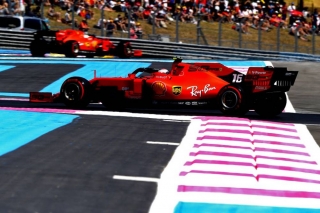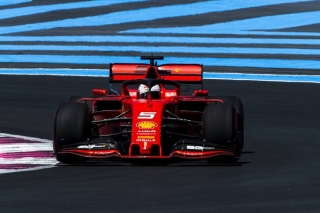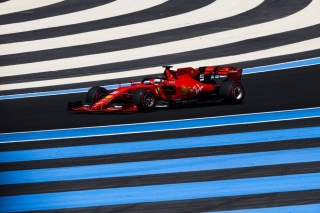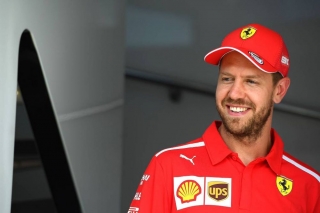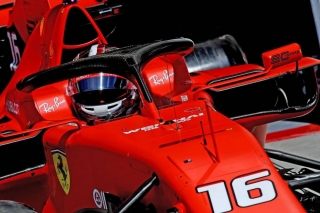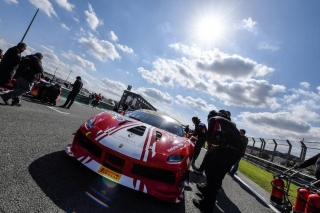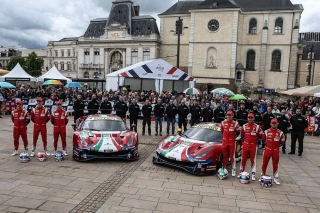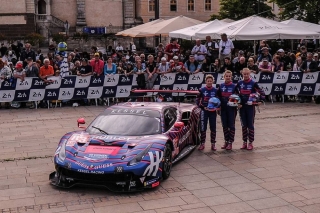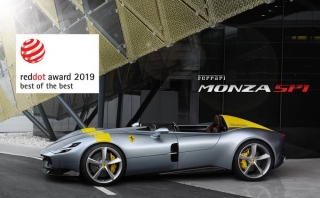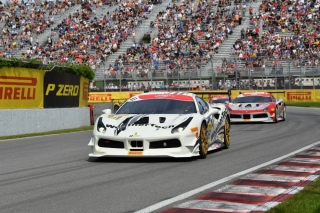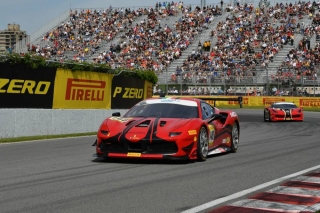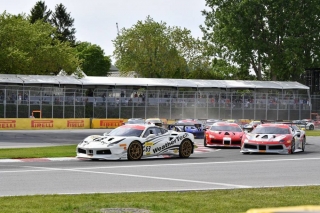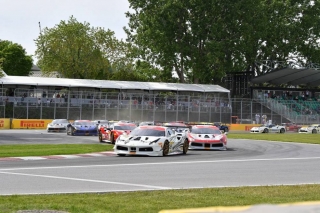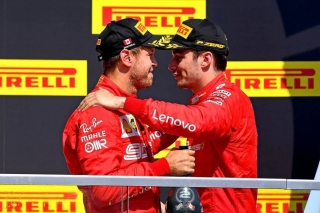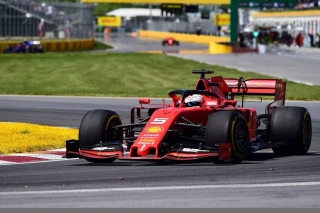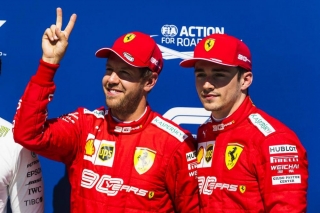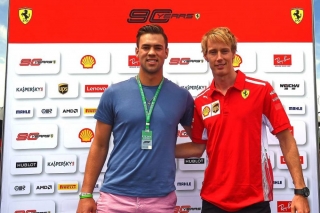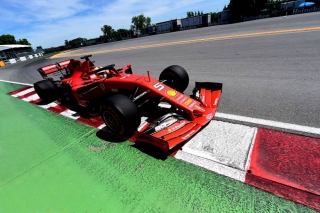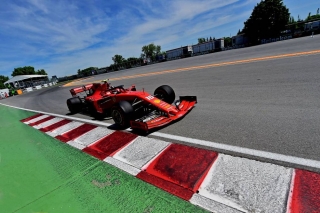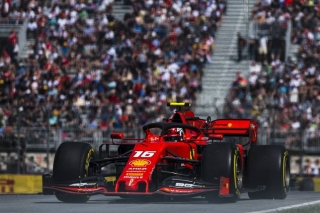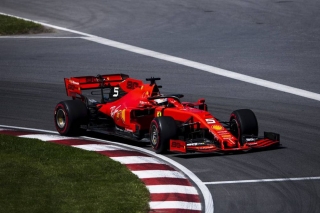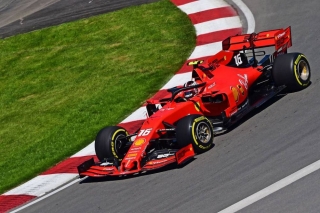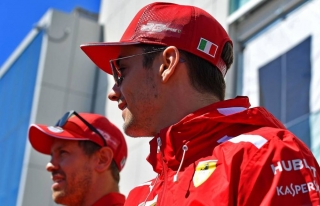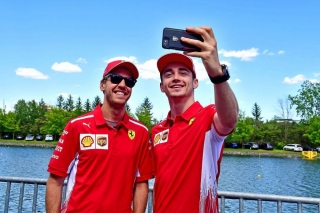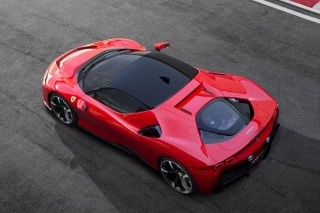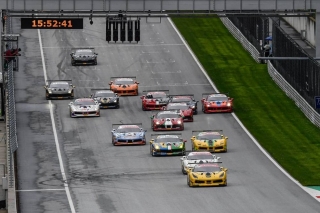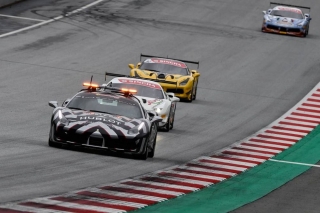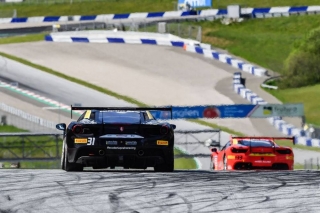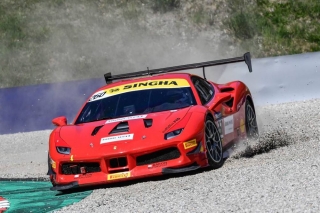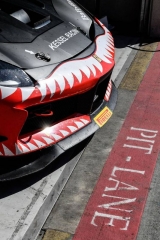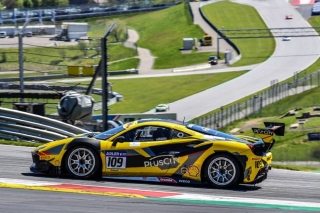Formula 1 Pirelli Grand Prix of France 2019 – A tricky Saturday
Posted: 22.06.2019
Source: Ferrari
Le Castellet, 22 June 2019 – Scuderia Ferrari drivers Charles Leclerc and Sebastian Vettel will start the 60th French Grand Prix from the third and seventh places on the grid respectively. The race gets underway at the Le Castellet circuit at 15.10 CET tomorrow.
Q1. Both drivers made the cut to Q2 without any problems, running the Soft tyres. Charles did a 1’31”441 on his first run, improving to 1’30”647. Sebastian’s first flying lap produced a 1’31”846 and he improved to 1’31”075
Q2. The Scuderia Ferrari duo then let the tyres cool down before setting off again to post laps of 1’29”934 and 1’30”128 respectively. At this point, getting to Q3 was not a foregone conclusion, so to make sure and to allow the drivers to start the race on less worn tyres, both SF90s were sent back out on track with new Medium tyres. Sebastian posted a 1’29”506 and Charles did a 1’29”699.
Q3. In the final top ten shoot-out, Charles and Sebastian once again ran the Softs, but while the Monegasque driver did a 1’29”015, the German lost time and decided to abort his run, pitting for fresh tyres. Leclerc did a second run on new Softs, getting down to 1’28”965 to secure third spot on the grid, behind pole man Lewis Hamilton and Valtteri Bottas. On his only attempt at taking pole position, Sebastian did a 1’29”799, which puts him in seventh place.
Charles Leclerc #16
“It has been a good weekend so far and I have felt comfortable in the car since FP1. For the past few weeks, my main target has been improving the car set up in order to suit the track evolution from Q1 to Q3. From this point of view, I am satisfied with my personal performance and have definitely made a step forward.
On the other hand, we are not where we should be, relative to our competitors in terms of lap times. We have a lot of work to do and I will push to have a good start in order to challenge them during the race tomorrow.”
Sebastian Vettel #5
“It was a bit of a funny session, as I didn’t get a consistent feel for the car and didn’t extract the maximum out of it, so I can’t be happy with that. On the last lap I just didn’t have the same feeling as during other parts of the session and that’s why we didn’t qualify where we should be. The car was better than where we ended up.
On the other hand, I am looking forward to tomorrow. It will be difficult to manage the tyres, but in the race, usually things settle down so it’s much more straightforward and should be more consistent, so let’s see what tomorrow brings.”
Mattia Binotto Team Principal
“We knew before coming here that this weekend would be more difficult than usual for us. Nevertheless, I think that compared to the Spanish Grand Prix, we have made a small step in the right direction, which is what we were looking to do.
Sebastian was not happy with his tyres in Q3. However, tomorrow’s race will be long, as are the straights, so there should be plenty of opportunities to move up the order.”
Formula 1 Pirelli Grand Prix of France 2019 – Charles and Sebastian all set for qualifying
Posted: 22.06.2019
Source: Ferrari
Le Castellet, 22 June 2019 –Charles Leclerc and Sebastian Vettel used the final free practice session of the French Grand Prix to fine tune their SF90s in preparation for qualifying, which gets underway at 3pm today.
28 laps. Charles and Sebastian concentrated on optimising the car for use on a qualifying lap, completing a total of 28 laps. The Monegasque driver posted a best time of 1’30”605, good enough to be third fastest behind Valtteri Bottas and Lewis Hamilton. Sebastian was fourth in 1’30”633.
Race. After today’s qualifying, which starts at 3pm, establishes the grid order, the 60thFrench Grand Prix will get underway at 15.10 tomorrow.
Formula 1 Pirelli Grand Prix of France 2019 – An evaluation day
Posted: 21.06.2019
Source: Ferrari
Le Castellet, 21 June 2019 – It was a very busy free practice Friday for Scuderia Ferrari in preparation for the French Grand Prix. Charles Leclerc and Sebastian Vettel worked on evaluating various updates brought to the Le Castellet circuit, as well as getting on with the usual qualifying and race preparation.
FP1. In the first session, the two SF90s took to the track for a few laps before pitting to have fitted some new components introduced for the French race. Charles and Sebastian then returned on track running just the Soft tyres, doing 21 and 22 laps respectively. The man from Monaco had a best lap of 1.33.111, which put him third, while the German was fifth in 1’33”790.
FP2. At the start of the afternoon session, Sebastian went out first on Medium then on Soft tyres while Charles ran the Medium compound. Both men then did some low fuel runs during which they set their fastest lap times. The number 16 SF90 stopped the clocks in 1.31.586, while in car number 5, Sebastian did a 1.31.665. In the second half of the session they also did some high fuel load runs to simulate some sections of the race, while assessing the behaviour of the car and tyres when track temperatures were in excess of 50 degrees.
Programme. The final free practice session starts at noon tomorrow, while qualifying gets underway at 3 pm. The 60th French Grand Prix begins on Sunday at 15.10.
Charles Leclerc #16
“I am generally happy with how our sessions went today. The feeling in the car was good and we tested some new parts. We are confident but we still have a lot of work ahead of us to put the car in the best condition for a strong qualifying.
Our competitors are strong and we must focus on ourselves to really put everything together for tomorrow. It was fun to drive on this circuit again. It is a bit of a different track to the others because the walls are so far away that you can push and try more during practice. I look forward to being back in the car tomorrow morning.”
Sebastian Vettel #5
”I would say we have a lot of work ahead of us since not all the new parts we have here performed exactly as expected. I think we have a lot of data to analyze overnight, to possibly have a bit better performance tomorrow. On the Canada matter I would say we felt that we didn’t share the opinion of the stewards during the race in Canada and we thought that we could bring something new. It is disappointing that the matter is not going any further but that is what we have now and so we have to move on.”
Formula 1 Pirelli Grand Prix of France 2019 – Free practice 2: Charles third, Sebastian fourth
Posted: 21.06.2019
Source: Ferrari
Le Castellet, 21 June 2019 – The result of the second session followed pretty much the same patter as the first, with the Ferraris of Charles Leclerc and Sebastian Vettel finishing up third and fourth behind the Mercedes of Valtteri Bottas and Lewis Hamilton.
63 laps. Between them the two SF90s completed 63 laps, 31 for the Monegasque driver and 32 for the German. Charles’ best time was a 1’31”586, with Sebastian posting a quickest lap of 1’31’665.
Saturday. The final hour of free practice starts at noon tomorrow, while qualifying gets underway at 3pm. The French Grand Prix begins on Sunday at 15.10.
Formula 1 Pirelli Grand Prix of France 2019 – Free practice 1: Charles third, Sebastian fifth
Posted: 21.06.2019
Source: Ferrari
Le Castellet, 21 June 2019 – At the end of the first free practice session for the French Grand Prix at the Le Castellet circuit, Charles Leclerc was third quickest and Sebastian Vettel was fifth.
43 laps. Their SF90s, Charles completed 21 laps with Sebastian doing 22. The Monegasque driver’s best time was a 1’33”111, while Sebastian stopped the clocks in 1’33”790.
Second session. The cars are back on track for a further 90 minutes at 15h00.
Formula 1 Pirelli Grand Prix of France 2019 – “Maximising our potential”
Posted: 20.06.2019
Source: Ferrari
Le Castellet, 20 June 2019 – Activities got underway today for Scuderia Ferrari, in preparation for the French Grand Prix. The engineers began planning the schedule for Friday’s free practice sessions and went along with Charles Leclerc and Sebastian Vettel on the usual track inspection, walking round the 5.842 kilometre-long Paul Ricard track.
With the media. Both drivers had their usual press meeting in the afternoon. Sebastian Vettel said he was very happy to be getting back behind the wheel: “We have a few new parts on the car, trying a few things,” said the German. “Tomorrow will be very important for us. The track is not exactly the same as last year as some sections have been resurfaced and this circuit has a bit of everything. We hope the data we get tomorrow will show that we can make a step forward in the areas that, so far, have been our weak points. We know our car is very competitive in terms of straight line performance, but we lack a bit of grip in the corners, so we lose or gain time depending on which track we are at. Here we have a good mix of both elements, including some corners that could potentially be difficult for us, but we have some updates that should see us make a step forward.”
On the attack. Next to face the media in the Scuderia Ferrari motorhome was Charles Leclerc. Yesterday, in Bandol, a town close to the circuit, he took part in a charity football match, in memory of Jules Bianchi. The Monegasque driver said he was ready to push really hard to do well on this track, which is but 200 kilometres from his home in Monte Carlo. “Everyone thinks I know this track well because it’s very close to where I live, but to tell the truth, last year was my first time racing here,” he explained. “However, the kart track where I first raced is in Brignoles, which is very near here, so I’m happy to be here.” As for his expectations for this weekend, like all the drivers, Leclerc said he was aiming for a top result. “I’d like to take pole, but if that’s not possible, you can be sure I will be trying my utmost to get the very best result I can on Saturday. The same applies on Sunday, but before that, we need to think about free practice when we will try and understand how to maximise the potential of our package.”
Programme. The first two free practice sessions for the French Grand Prix take place tomorrow at 11 and at 3pm. On Saturday, the final hour of preparation prior to qualifying is at noon, while the pursuit of pole begins at 3 in the afternoon. The 60th French Grand Prix gets underway at 15.10 on Sunday.
Formula 1 Pirelli Grand Prix of France 2019 – “It all began in France”
Posted: 18.06.2019
Source: Ferrari
Maranello, 18 June 2019 – The 60th French Grand Prix to count towards the Formula 1 World Championship takes place this weekend at the Paul Ricard circuit near the commune of Le Castellet in the south of France. It is the eighth round of this season and the 16th time the circuit has hosted the race. The French Grand Prix dates back to the earliest days of motorsport and the very first Grand Prix motor race was the 1906 French Grand Prix. The name of the race, “Grand Prix” translating as “Big Prize” proved to be true as the winner was presented with 45,000 Francs, equal to approximately 13 kilos of gold. This race has been held at seven different venues and Scuderia Ferrari has won it 17 times.
Reims and Rouen. In 1950, the first year of the world championship, the French round was held at Reims, but the Scuderia’s first win came when the race had moved to Rouen in 1952. Alberto Ascari did the honours at the wheel of a 500. The following year, the Maranello marque duly won at Reims, with Englishman Mike Hawthorn taking his first win. There were four more victories at Reims, Peter Collins (1956), Hawthorn again (1958), Tony Brooks (1960) and Giancarlo Baghetti who amazingly took an incredible win in the 156F1 on his debut in the category in 1961. The very last win for Ferrari at this track came in 1968, courtesy of Jacky Ickx.
Le Castellet. The Paul Ricard circuit first hosted the French Grand Prix in 1971, but Scuderia Ferrari had to wait for its first victory in the hills of the Var region until 1975, when Niki Lauda did the honours. Today, the track offers no fewer than 167 different configurations. Its most famous feature is the very long Mistral straight and the extremely high speed and challenging Signes corner: in the old days, journalists would spectate from there to listen out and decide which drivers were taking it flat out.
In 1990. Scuderia Ferrari’s second win at Le Castellet came in 1990, with Alain Prost giving the Maranello team its one hundredth Formula 1 victory. The French Grand Prix had been absent from the calendar since 2008, when it returned at Le Castellet last year.
At Magny-Cours. From 1991, the race moved from the south coast to the very centre of the country, at Magny-Cours. Scuderia Ferrari had a great track record here starting in 1997: Michael Schumacher took six wins in ten years (1997, 1998, 2001, 2002, 2004 and 2006). The team also won the following two years, in 2007 with Kimi Raikkonen and in 2008 with Felipe Massa.
Timetable. The cars will take to the Paul Ricard circuit for the first time on Friday at 11 o’clock for the first free practice session, with the second one scheduled for 3pm. The final hour of preparation comes on Saturday at noon, while qualifying gets underway at 3pm. The French Grand Prix starts at 3.10om on Sunday 23 June.
FERRARI STATS
GP participations 977
Seasons in F1 70
Debut Monaco 1950 (Alberto Ascari 2°; Raymond Sommer 4°; Luigi Villoresi rit.)
Wins 235 (24,05%)
Pole positions 221 (22,62%)
Fastest laps 250 (25,58%)
Total podiums 754 (77,48%)
FERRARI STATS FRENCH GP
GP partications 49
Debut 1950 (Peter Whitehead 3rd)
Wins 17 (29,31%)
Pole positions 17 (29,31%)
Fastest laps 14 (24,13%)
Total podiums 49 (84,48%)
Charles Leclerc #16
“France – it’s a pretty new track to me, strangely, as it is very close to my home. I have some great memories from last year’s event which was the first time that I was there. It was also the first time that I made it to Q3 in Formula 1, which is something that I will never forget.
The track is quite atypical, with huge run-off areas. You can really push the limits in free practice without taking actual risks because the walls are quite far away. I really enjoy driving at Le Castellet and look forward to being back there.”
Sebastian Vettel #5
“Last year’s French Grand Prix was our first at the Circuit Paul Ricard for many years, so returning this year we have more data to work with. The circuit has long straights and low-speed corners, although there is a wider range of corner speeds there. Most of the corners have been resurfaced since last year.
We have a one step harder tyre selection than in Montreal and it is likely to be another one-stop race. The weather can be unpredictable here and is often very hot and windy.
Last year our race was compromised by the first lap incident but I think our car can have the pace to do quite well there.”
Mattia Binotto Team Principal
“Following Canada we definitely want to get back on track and go racing with our rivals once again. In France we will have a few small evolutions, elements that represent for us a useful step in defining the direction we will take in developing the car.
What we will be bringing won’t be the solution to our problems, but the technical feedback we get from these evolutions will be important for the next steps we take.
Paul Ricard has been a tricky circuit for us last year and we know that this kind of track isn’t particularly favourable for our package, but nothing is impossible so we will be ready to do our best.”
Michelin Le Mans Cup 2019 – Round 3 – Road to Le Mans – Eight Ferraris on the Road to Le Mans
Posted: 12.06.2019
Source: Ferrari
Maranello, 12 June 2019 – The first free practice sessions of the Road to Le Mans 2019, the most eagerly awaited event of the Le Mans Cup, are now just a few hours away. Eight Ferraris will line up for the third round of the series out of a total of 49 cars, 17 of which will be competing in the GT3 class representing six different manufacturers.
The situation. The championship thus far has been a duel between the two Ferraris of Kessel Racing and Luzich Racing, respectively crewed by the reigning champions Sergio Pianezzola and Giacomo Piccini, and Mikkel Mac and Fabien Lavergne. The Italian pair tops the standings on 44 points after victory at Le Castellet and second place at Monza. Luzich Racing, on its debut in the series, is in second with 41 points, courtesy of third place in the debut race and a win in Lombardy. Then further back in third, the crew of Beechdean AMR is on 22 points.
Kessel 4. Along with the 488 GT3 of Pianezzola and Mac, the Swiss team is fielding three other Ferraris. The first is driven by the British pair John Hartshorne and Oliver Hancock, regular competitors in the series, who are joined by the Americans Philippe Mulacek and Anthony Lazzaro and, in the fourth car, the US driver Pierre Mulacek and the German Pierre Kaffer.
Spirit of Race trio. Three cars will carry the colours of the Swiss team. The first is no. 51, with Maurizio Mediani and Christoph Ulrich again at the wheel, after a podium finish at Monza. Francesco Piovanetti and Oswaldo Negri Jr (no. 52) and Kriton Lentoudis and the experienced Rui Aguas will drive the other two cars along the 13-kilometre La Sarthe circuit.
Programme. The first free practice session takes place today, with the second on Thursday, followed by two qualifying sessions and the first of the two 55-minute races, which is due to start at 5:30 pm. On Saturday, Race-2 sets off at 11:30 am.
Ferrari Challenge Europe 2019 – Round 4 – Le Mans – Sixty-one drivers to compete in Ferrari Challenge Europe at Le Mans
Posted: 11.06.2019
Source: Ferrari
Maranello, 11 June 2019 – Excitement is mounting for the fourth round of the Ferrari Challenge Europe at the La Sarthe circuit on Saturday 15 June, just hours before the legendary 24 Hours of Le Mans. It is a special event, different from any other in the Prancing Horse one-make series, which will see all the 488 Challenge on track for a single 35-minute race that promises to be extraordinarily hard-fought and exciting. Sixty-one competitors are registered for the event, including some drivers who usually participate in the other two international series of the Prancing Horse, the North America and Asia-Pacific. From the North American Championship, held last weekend in Montreal in conjunction with the Formula 1 Grand Prix, we will see among others Thomas Tippl and Lisa Clark. The former is the Coppa Shell reigning champion, while the latter is the Ladies Cup leader and is aspiring rival of Agata Smolka.
Trofeo Pirelli. As there is still all to play for in the standings, the extra points awarded by the French race offers drivers a chance to turn the season around. Niccolò Schirò, currently leading with 73 points, after a difficult weekend in Spielberg only has a three-point advantage over Louis Prette and nine over Sam Smeeth. Thomas Neubauer, absent from Austria, and especially Bjorn Grossmann, aim to make up respective gaps of 23 and 25 points from the leader. The nine entrants also include Adam Carroll, the winner in Spielberg, and the 28-year-old Belgian John Wartique, who has driven in the GP3 Series and is making his debut in the one-make series.
Trofeo Pirelli AM. In this class, 17 cars will compete for the final victory even if it is difficult to imagine any shake-up in the overall rankings, dominated by Jack Brown on 91 points, courtesy of two consecutive victories and consistent performances. The Briton is the only driver to have finished on the podium in every race. Behind him, on 77 points, Emanuele Maria Tabacchi should do better than his duck in Austria, which hit his hopes for the title. The Italian driver started the season with two wins in Bahrain, followed by two second places in Valencia. Behind these two come four drivers all on 31 points: Jan Danis, Frederik Espersen, Martin Nelson and Christian Overgaard. From the US, Chris Carel and Eric Marston will try to stand out in a very competitive grid.
Coppa Shell. With 18 drivers entered, the Coppa Shell is the most popular class on the grid. The Lebanese Tani Hanna tops the standings with 89 points, after two wins and two podiums, followed 14 points behind by Ernst Kirchmayr, who won Race-2 in Valencia and Spielberg, in what was his home race. Canadian Eric Cheung, one of the fastest on the track, with his 62 points, is banking on this race to put himself back in mix for the title, as are Christian Kinch and Ken Abe, respectively on 59 and 57 points. This class sees four drivers from the Challenge North America, the highest number. Besides the already mentioned Thomas Tippl, there will be Dale Katechis, Geoffrey Palermo and Brent Holden, while “Baby Kei” will join the group from the Asia Pacific series.
Coppa Shell AM. The races and the championship in this class where three drivers are separated by just four points have been marked by balance and uncertainty. The Belgian Laurent De Meeus leads the standings, with four second places and points from every race. After skipping the first outing, Henrik Jansen has powered up the rankings with three wins and is only two points behind De Meeus. The Polish Agata Smolka is in third position on 74 points, having enjoyed an excellent first half of the season with two victories. Of the 17 competitors in this class, three come from the North American Challenge, Lisa Clark, Mark Fuller and Al Hegyi.
History. This will be the fourth time in its 27 years that the Ferrari Challenge will run on the track made famous by the French marathon. The first was in 2011 when about 50 of the 430 and 458 Challenges took to the track, a figure repeated in 2013. In 2016, the Challenge appeared at Le Mans for the 84th edition of the French classic, with over 40 cars starting the race on one of the world’s most famous tracks. That year Marcello Puglisi won in the Trofeo Pirelli, Sam Smeeth in the Trofeo Pirelli AM and Vladimir Hladik in the Coppa Shell.
Programme. The programme for the fourth round of the Ferrari Challenge Europe is different from usual, concentrating the track activities into two days. Two free practice sessions are due on Thursday, at 10 am, and 11:25 am, both 45 minutes long. The 60-minute race for pole position starts at 3 pm. On Friday no track activities take place, as usual at Le Mans, but for the first time, the drivers of the Ferrari Challenge will join their 24 Hours colleagues in the parade through the streets of the city centre. The 35-minute race sets off on Saturday at 10:15 am, broadcast live and free on live.ferrari.com.
Ferrari Museum celebrates Scuderia Ferrari’s landmark anniversary with the “90 Years Exhibition”
Posted: 05.06.2019
Source: Ferrari
“Hypercars”: the story of Ferrari’s technological evolution told through milestone cars
Maranello, 05 June 2019 – One of the great iconic names in motorsport with the power to unite an entire country and millions of fans from all over the world: the Scuderia Ferrari – the most successful team in the history of Formula 1 – turns 90 in 2019. An anniversary that the Ferrari Museum in Maranello has decided to mark with a major celebratory exhibition.
Founded in Modena on 16 November 1929 by Enzo Ferrari who understood the potential of gentlemen drivers to deliver great racing performances, Scuderia Ferrari has written many of the most unforgettable chapters in motorsport. The team which began using Alfa Romeo cars was first known as Società Anonima Scuderia Ferrari. It quickly sped to prominence on both the Italian and world stages, rapidly entrusting its cars to the leading drivers of the day in categories of all kinds. These included the Mille Miglia, the very first event for Scuderia Ferrari in 1930, followed by the Targa Florio, the Trieste-Opicina hillclimb where Tazio Nuvolari gave the marque its first ever win and classic endurance races like the 24 Hour races at Le Mans, Daytona, Spa and the Sebring 12 Hours, and, of course, Formula 1.
The cars featured in the “90 Years” exhibition are a testament to that glorious history, beginning with the Alfa Romeo 8C 2300 Spider, which became the very first car to sport the Prancing Horse as part of its livery at Le Mans in 1932. The final car of the exhibition is the SF71H: the single-seater in which Sebastian Vettel and Kimi Räikkönen raced in only last season.
In the exhibition, the timeframe separating these two cars is filled with a string of unforgettable single-seaters, the stars of hard-fought races, crushing defeats and historic victories alike. The Ferrari 500 F2, in which Alberto Ascari won two world titles in a row in 1952 and 1953, and the Ferrari D50 that Juan Manuel Fangio drove to take the fourth of his five world titles. Also featured is the Ferrari Dino 246 F1 that helped Mike Hawthorn beat Stirling Moss to the World Champion crown by a single point. The series continues with the Ferrari 156 F1 which gave John Surtees in 1963, the only man to be world champion on two and four wheels, his first win. Also on show are the 1975 312 T with its revolutionary transverse gearbox which helped a young Niki Lauda to win his first World Championship, and the 312 T4 driven by Gilles Villeneuve, the same model in which Jody Scheckter won in 1979. Jody Scheckter took the Drivers’ title in 1979. Not to be missed is the Ferrari F2004, the car in which Michael Schumacher delivered 13 wins – including six consecutive ones – to take his final World Champion title in 2004. Scrolling down the long list a little further, is the F2007, in which Kimi Räikkönen brought the Drivers’ title back down to Maranello, after an epic race to win in Brazil, snatching the title by a single point.
All of these cars brilliantly encapsulate and epitomise Enzo Ferrari’s dream, and the commitment, determination and passion for innovation of the most successful team in the history of Formula 1. Its tally of 31 World titles (15 Drivers’ and 16 Constructors’) is an unequalled record that the Maranello team continues to defend and honour each season with the same passion of 90 years ago.
The exhibition pays homage also to Ferrari victories in enclosed wheel racing. The 166 MM in the exhibition, for example, gave Ferrari its first win in the 24 Hours of Le Mans 70 years ago, followed by triumph in the 24 Hours of Spa and the Mille Miglia. The 275 P, on the other hand, dominated the 12 Hours of Sebring in 1964 before going on to win the Nürburgring 1000km and the 24 Hours of Le Mans.
Hypercars – milestones in automotive history
The Maranello Museum is also staging the glorious “Hypercars” exhibition dedicated to all the Ferraris that signalled landmark advances in the marque’s technological evolution.
Every Ferrari is special and the preserve of the lucky few who become clients. Many Prancing Horse models have been the catalyst for constant innovation and accelerated technological progress that have set new benchmarks in the sector. This is the Maranello signature when it comes to its Hypercars, a term that refers to milestones in motoring history. These cars are all limited series and the product of Enzo Ferrari’s personal philosophy of aiming to make every new model the best car of its day. The result is that each new, more advanced addition is the embodiment of genuinely leading-edge research, setting the benchmark in the automobile world. This exhibition now offers visitors the opportunity to view just such examples of Ferrari technological excellence.
First off is the 1984 GTO, an iconic car clothed in aggressive yet elegant lines designed to revive the legendary Gran Turismo Omologato moniker, inherited from the 250 GTO.
Three years later, however, Ferrari unveiled the mother of all modern Hypercars: the F40. Created as Enzo Ferrari’s personal celebration of the company’s 40th anniversary, the F40 is a genuine track car with all the consequent blistering power and performance that can be expected, thanks to the turbo engine and the use of composites with dominated F1 at that time.
In 1995, Ferrari ushered in a whole new era with the F50, essentially a Formula 1 car in GT clothing. For the first time too, the engine, which was derived from the 1990 F1 car, was bolted directly to the monocoque chassis as a stressed member. An awe-inspiring car that delivered authentic track-style ground effect thanks to over 2,000 hours of wind tunnel work.
The 2002 Ferrari Enzo, the hypercar dedicated to the founder and developed in consultation with Michael Schumacher, was the very pinnacle of road-going achievement of its day. Inspired by the Ferrari single-seater, it featured a particularly innovative human-machine interface which saw a series of controls moved to the steering wheel at the specific behest of the German world champion. These included the forebear of the legendary Manettino, which would later appear on all the cars in the range.
Unveiled to the world in 2013 as its name implies the LaFerrari is the quintessence of a car produced by the Maranello brand. It was also the first Ferrari to sport a hybrid HY-KERS power unit inspired by the new generation Formula 1 cars, which unleashed just short of 1,000 horsepower. The targa-top version, the LaFerrari Aperta, was unveiled in 2016 and as a result of some superb aerodynamic work is just as efficient as its coupé sibling when its windows are up.
Also at the exhibition the design static model of Ferrari P80/C, the latest product of our One-Off programme which allows owners to create a truly unique version of an existing model, moulded around their personal wishes. Presented last April after four years of research and development, the P80/C is the only One-Off in Maranello history to be homologated solely for track use. Based on the Ferrari 488 GT3, it is a hugely sophisticated reworking of the concept behind the Sports Prototypes that has proved so successful in competition over the years.
As part of the journey through Ferrari’s signature exclusivity visitors also discover the Tailor Made programme through which the marque gives full expression to the soul of this super premium luxury brand. An entire room in the Museum has been fitted out to replicate the area in the Ferrari Style Centre where Ferrari’s most discerning clients go to personalise their cars. Colour palettes, fabric swatches, leather samples and a myriad of other materials offer a literally endless choice of combinations to allow clients to make their Ferrari as unique as their own personality and tastes.
The “90 Years” and “Hypercars” exhibitions are both running until May 2020.
FIA WEC Super Season 2018 – 2019 – Round 8 – 24 Hours of Le Mans 2019 – “Le Pesage”: the week of the 24 Hours of Le Mans begins
Posted: 10.06.2019
Source: Ferrari
Maranello, 10 June 2019 – The week-long countdown to the 24 Hours of Le Mans, the most eagerly anticipated race for fans of closed-wheel racing, has officially begun with the pre-race administrative checks and scrutineering, known in French as ‘Le Pesage’.
Kessel cars. This lasts two days and involves all the crews starting the French marathon in their respective classes. Most of the 488 GTEs entered were checked today, while yesterday saw the turn of the two cars of Kessel Racing.
Female crew. The much-admired no. 83 is one of the biggest attractions for the media and fans, driven in the LMGTE Am class by the all-female crew of Manuela Gostner, Rahel Frey and Michelle Gatting. The Swiss team’s second car, the no. 60, will be in the hands of three Italians Claudio Schiavoni, Sergio Pianezzola and Andrea Piccini, who usually compete in the European Le Mans Series.
The scrutineering and administrative checks are a highly anticipated event for fans, offering them a close look at the cars and drivers before the action shifts to the 13,262-metre Circuit de la Sarthe.
FIA WEC Super Season 2018 – 2019 – Round 8 – 24 Hours of Le Mans 2019 – Eleven Ferraris to start 24 Hours of Le Mans
Posted: 05.06.2019
Source: Ferrari
Maranello, 5 June 2019 – The countdown has begun to the highly anticipated 87th edition of the 24 Hours of Le Mans, the race that closes the 2018-19 Super Season of the FIA World Endurance Championship (WEC). In ten days, at the La Sarthe circuit, 62 cars will compete for the final victory in their respective classes and, among them, 11 sport the colours of the Prancing Horse.
LM GTE Pro. Three 488 GTE cars will start in the LM GTE Pro class, for professional drivers, lined up by AF Corse and Risi Competizione. In car no. 51, the reigning champions Alessandro Pier Guidi and James Calado welcome Daniel Serra, with whom they have previously competed in the 24 Hours, which counted as the second round of the season, and the 1000 Miles of Sebring. Then, in no. 71 Spanish driver Miguel Molina join the crew of Davide Rigon and Sam Bird. In addition to these two cars, usually involved in the FIA WEC, the no. 89 of Risi Competizione will be crewed by Pipo Derani, Oliver Jarvis and Jules Gounon.
LM GTE Pro-Am. In this class, eight 488 GTEs will compete on the 13,626 metres of the legendary French circuit. The Spirit of Race crew, with Giancarlo Fisichella, Thomas Flohr and Francesco Castellacci, hope to take advantage of the double points on offer in this race to bridge the 23-point gap separating them from the leaders of the Pro-Am class. The Clearwater Racing and MR Racing crews are unchanged from previous FIA WEC races: the Singapore team will field Luis Perez Companc, Matthew Griffin and Matteo Cressoni, while Motoaki Ishikawa, Olivier Beretta and Eddie Cheever III will represent the Japanese team. In its 24 Hours of Le Mans debut the Japanese team Car Guy Racing, winner of the Asian Le Mans Series, will deploy Frenchman Côme Ledogar alongside its regular drivers, Kei Cozzolino and Takeshi Kimura. All eyes will be on the 488 GTE of WeatherTech Racing, fastest in the pre-race test session, with the British Robert Smith joining the usual pairing of Cooper MacNeil and Toni Vilander. Jeffrey Segal, Rodrigo Baptista and Wei Lu are set to drive the JMW Motorsport car, distinguished by an original livery in tribute to this legendary race. The two Ferraris representing Kessel Racing also carry a new livery. Car no. 60 will deploy the crew taking part to the European Le Mans Series, Claudio Schiavoni, Sergio Pianezzola and Andrea Piccini, while the no. 83 sees an all-female crew of Manuela Gostner, Rahel Frey and Michelle Gatting, previously on the podium in the debut race of the ELMS series. The trio will write a new chapter in the history of women in the French classic. The first and only previous female crew to drive the 24 Hours at the wheel of a Ferrari did so in 1951 when Betty Haig and Yvonne Simon crossed the line in 15th place in a 166 MM Berlinetta.
Anniversary. Ferrari has decided to celebrate the 70th anniversary of its first victory at Le Mans in 1949 with a special logo on the roof of the two AF Corse 488 GTEs. That triumph also went down in history because race winner Luigi Chinetti, drove the 166 MM almost throughout, beating his rivals in cars with twice the cylinder capacity of Ferrari engines. He only briefly handed the wheel to the car’s owner and team-mate, Lord Selsdon (still Peter Mitchell-Thomson at the time), during a quiet phase of the race.
Race build-up. The week of the 24 Hours of Le Mans opens on Sunday 9 June with the technical scrutineering and the so-called ‘pesage’ ceremony at Place de la République. From Wednesday 12, starting at 4 pm, the cars go on track for free practice and the first qualifying session followed on Thursday by the second and third sessions. As usual, Friday is a rest day, but one that will include a big party and parade through the city centre. The 24 hours starts on Saturday 15 June at 3 pm.
Ferrari takes the Red Dot: Best of the Best award for the Monza SP1
Posted: 04.06.2019
Source: Ferrari
Flavio Manzoni and the Ferrari Design team receive the title of honour: Red Dot: Design team of the Year 2019
Ferrari’s tally of Red Dot Awards is now 14 in five years
The award ceremony of the Red Dot Award: Product Design 2019 will be held in Essen, Germany on the 8th of July, when Ferrari will receive two prestigious accolades: the Red Dot: Best of the Best award for the Monza SP1 and an honorary recognition for the design team led by Flavio Manzoni.
Between 2015 and 2019, Ferrari has won no fewer than 14 distinctions in the Red Dot Award: Product Design, and the jury has bestowed the highest distinction in the competition, the Red Dot: Best of the Best on five models in a row. After the awards for the FXX-K, 488 GTB, J50 and Portofino, this year sees the Monza SP1 receive the accolade for its innovative and aesthetically outstanding design. In the history of the design award no other automotive manufacturer has ever achieved this result.
During the award ceremony, Flavio Manzoni and his design team will also receive the “Radius” challenge cup and be officially announced as “Red Dot: Design Team of the Year”.
In extolling the Ferrari Design team for the award, Professor Dr. Peter Zec, founder and CEO of the Red Dot Award, explained: “Ferrari understands better than any other company how to make luxury sports cars objects of desire. The designers use state-of-the-art technology and an emotionally appealing language of form to create an incomparable driving and brand experience.”
“Receiving such a prestigious award,” commented Flavio Manzoni, Senior Vice-President for Design at Ferrari, “encourages all the members of the Ferrari Design Team to draw new creative stimulation, which fuels our passion for our work.”
Four days after the award ceremony, a special exhibition designed by Ferrari will be on show in the Red Dot Design Museum Essen alongside the “Design on Stage 2019” and “Milestones in Contemporary Design 2019” exhibitions, which feature all of the winning products in the Red Dot Award: Product Design.
Ferrari Challenge North America 2019 – Round 4 – Ferrari Challenge Wraps Up Epic Weekend in Montreal
Posted: 09.06.2019
Source: Ferrari
Montreal, Quebec | 09 June 2019 – Run under perfect conditions, Ferrari Challenge put on quite a show with an immense amount of action throughout the thirty car field. Picture perfect weather conditions that have been sustained throughout the Grand Prix weekend persisted to ensure that drivers were able to enjoy the Circuit Gilles Villeneuve in ideal circumstances.
Trofeo Pirelli. Cooper MacNeil (Scuderia Corsa, Ferrari of Westlake) led home Benjamin Hites (The Collection) in race 2, ultimately finishing four and a half seconds ahead of the young driver. The start proved decisive at the front of the Trofeo Pirelli category as Cooper was able to establish position going into turn 1 and then through the much slower turn 2. Further back, drama amongst Marc Muzzo (Ferrari of Ontario) and James Weiland (Ferrari of San Francisco) ultimately resulted in Marc Muzzo claiming his first podium in 2019. The Canadian driver crossed the line with just a second and a half to spare.
Trofeo Pirelli AM. Brent Holden (Ferrari of Newport Beach) took his first win of the season in the Trofeo Pirelli AM category, crossing the line ten seconds ahead of his nearest competitor, Dave Musial (Ferrari of Lake Forest). Neil Gehani leveraged a back up car to take the grid after his incident in race 1, and used it to good affect, earning another podium, this time by only eight tenths of a second over Jose Valera (Ferrari Ft. Lauderdale).
Coppa Shell. Drama at the start took pole sitter Mark Issa (Ferrari of Atlanta) out at the very start after he was a bit overenthusiastic. Mark’s adventure also cost Ziad Ghandour (Boardwalk Ferrari) who was eliminated from competition in the Trofeo Pirelli class. That left the door open for Claude Senhoreti (Ferrari of Ft. Lauderdale) to return to the podium, but this time in the first place position. Claude also demonstrated excellent pace of his own, finishing in fifth overall, and nearly twenty seconds ahead of his nearest competitor in the Coppa Shell category, Dale Katechis (Miller Motorcars). Oscar Paredes Arroyo (Ferrari of Ft Lauderdale) completed the Coppa Shell podium.
Coppa Shell AM. Jay Schreibman (Cauley Ferrari) took the win in race 2, beating out Brad Horstmann (Foreign Cars Italia) and Gianni Grilli (Ferrari of Quebec) who rounded out the top three. The Coppa Shell AM category ultimately ended up quite strung out as Jay was able to fight amongst the Trofeo Pirelli Am category while Brad Horstmann was sandwiched by two drivers from Coppa Shell. Gianni Grilli also built quite a gap on Mark Davies (Wide World of Cars), who fell back to nearly ten seconds from Gianni by the time the checkered flag fell.
Schedule. Ferrari Challenge will return to the track on July 26, at the famed Indianapolis Motor Speedway.
Ferrari Challenge North America 2019 – Round 4 – An Early Stop for Race 1 in Montreal
Posted: 08.06.2019
Source: Ferrari
Montreal, 8 June 2019 – Ferrari Challenge competition in Montreal had hardly passed the ten minute mark when a significant incident that began with Lisa Clark (Scuderia Corsa, Ferrari of Beverly Hills) left oil on the racing surface and triggered a chain of consequences that took several strong cars out of contention. An extensive safety car period was required, but despite the diligent efforts of the track safety workers, the series was unable to return to green-flag conditions.
Trofeo Pirelli. Cooper MacNeil (Scuderia Corsa, Ferrari of Westlake) again claimed victory at Montreal over James Weiland (Ferrari of San Francisco) and Benjamin Hites (The Collection). Cooper had begun to stretch a gap before the race was neutralized behind the safety car. Further back, Thomas Tippl (Scuderia Corsa, Ferrari of Beverly Hills) had a tough go of it, falling back several places in the first lap, first corner melee. Marc Muzzo (Ferrari of Quebec) was one of the beneficiaries and the Canadian driver showed strong pace, before his progress was blunted by the safety car.
Trofeo Pirelli AM. Ziad Ghandour (Boardwalk Ferrari) took the win after Barry Zekelman (Ferrari of Ontario) and Neil Gehani (Continental Autosports) were caught up in the turn 13 mess instigated (by no fault of her own) by Lisa Clark’s mechanical difficulties. This allowed Ziad to inherit the win, beating out Dave Musial (Ferrari of Lake Forest) and Jose Valera (Ferrari of Ft. Lauderdale) who rounded out the podium.
Coppa Shell. Mark Issa (Ferrari of Atlanta) took another win, beating out Claude Senhoreti (Ferrari of Ft. Lauderdale). Claude was able to eek by Brian Davis (Ferrari of Palm Beach) in the first lap chaos before the safety car put an end to competitive racing action.
Coppa Shell AM. Eric Marston (Scuderia Corsa, Ferrari of Westlake) had a strong race, and strong race pace to both get past Jay Schreibman (Cauley Ferrari) and to keep the rest of a highly competitive Coppa Shell AM category behind him. Eric, Brad Horstmann (Foreign Cars Italia) and Gianni Grilli (Ferrari of Quebec) all made it past Jay Schreibman who encountered first the opening lap chaos and lost out the most among his fellow drivers.
Schedule. Ferrari Challenge will return to the circuit on Sunday immediately before the start of Formula 1 pre-race festivities at 11:15am (all times in ET).
Ferrari Challenge North America 2019 – Round 4 – Grids set for Ferrari Challenge in Montreal
Posted: 08.06.2019
Source: Ferrari
Montréal, 08 June 2019 – The North American circuit of Ferrari Challenge Trofeo Pirelli continued its 2019 season with the most anticipated stop of the year, at the Grand Prix du Canada. Running in support of the Scuderia, thirty three Ferrari Challenge pilots negotiated the tight confines and unforgiving barriers of the Circuit Gilles Villeneuve, located minutes from downtown Montreal. Due to the tight timelines required for the weekend, Ferrari Challenge merged its two qualifying sessions into one, with drivers’ fastest laps setting the grid for race 1 and their second fastest laps setting the grid for race 2.
Trofeo Pirelli. Cooper MacNeil (Scuderia Corsa, Ferrari of Westlake) took pole position for race 1 and race 2, setting fastest and second fastest lap. For race 1, that meant starting ahead of Thomas Tippl (Ferrari of Beverly Hills) and James Weiland (Ferrari of San Francisco). While Cooper was well clear with a fastest lap half of a second better than Thomas could manage, the battle for third through fifth was quite tight. James Weiland finished only two tenths off and Benjamin Hites (The Collection) was just under two one-hundredths of a second off. When it was time to set second fastest laps, Benjamin was able to close the gap to Cooper considerably, ending up just under three tenths of a second slower than the American driver. James Weiland completed the top three, a further three tenths down and it was Thomas Tippl’s turn to just miss the top three, just four one-hundredths off of the pace of the top three.
Trofeo Pirelli AM. Barry Zekelman (Ferrari of Ontario) took pole position honors for race 1 at Montreal, beating out Neil Gehani (Continental Autosports and Brent Holden (Ferrari of Newport Beach). The Canadian driver took pole for race 1 by nearly two tenths of a second based on his fastest lap time and he repeated the trick for his second fastest lap, setting another time good for pole position in race 2 as well. Brent Holden jumped Neil Gehani for second, but only by less than one tenth of a second setting up a fascinating duel for the upcoming races.
Coppa Shell. Mark Issa (Ferrari of Atlanta) took pole position for both races in his Ferrari 488 Challenge car, beating out Brian Davis (Ferrari of Palm Beach) by just under two tenths of a second. The two were in a class of their own within the Coppa Shell category, beating out third place runner Dale Katechis (Miller Motorcars) by almost a full second in their fastest laps, setting the grid for race 1. Based on the group’s second fastest laps, however, Dale Katechis was able to reign in and overtake Brian Davis, earning the second spot for the Sunday finale. The two were only one one-hundredth of a second apart, and were again well separated from the rest of the Coppa Shell category.
Coppa Shell AM. Jay Schreibman (Cauley Ferrari) claimed pole on the basis that his fastest lap was two tenths of a second clear from the best that Eric Marston (Scuderia Corsa, Ferrari of Westlake) could manage. The two were a further three tenths up the road from the best that Bradley Horstmann (Foreign Cars Italia) could accomplish, and so he will start third in race 1. Jay was also able to demonstrate his consistency, earning pole position for race 2 based on his second fastest lap in the session. Brad Horstmann will start ahead of Eric Marston, where the margin between second and third was again split by the slimmest of margins, seven one-hundredths of a second.
Schedule. Ferrari Challenge will take to the track for race 1 at 3:30pm (all times in ET) and will return to the circuit for race 2 action on Sunday at 11:15am.
Ferrari Challenge North America 2019 – Round 4 – Ferrari Challenge readies for return to Montreal
Posted: 04.06.2019
Source: Ferrari
Englewood Cliffs, New Jersey, 4 June 2019 – The North American leg of Ferrari Challenge Trofeo Pirelli continues this weekend in Montreal Canada, where drivers will once again support the Grand Prix du Canada and the Scuderia.
Trofeo Pirelli. Cooper MacNeil (Scuderia Corsa, Ferrari of Westlake) took the opportunity to solidify his standing over Benjamin Hites (The Collection) after a contentious weekend at WeatherTech Raceway Laguna Seca. The two drivers collided in Race 2, immediately ending Benjamin’s race while Cooper was able to carry on and score more valuable points. With eight races to go, the Chilean driver still has plenty of time to close the gap, but will be looking for strong performances at both races in Montreal. Thomas Tippl (Scuderia Corsa, Ferrari of Beverly Hills) and Martin Burrowes (Ferrari of Ft Lauderdale) remain locked in a tight battle for third in Trofeo Pirelli after Martin took a surprise win in race 2 at Laguna Seca.
Trofeo Pirelli AM. Ziad Ghandour (Boardwalk Ferrari) continues to hold the points lead in the Trofeo Pirelli AM category despite a difficult weekend at Laguna Seca. After his promotion from the Coppa Shell category by which he also keeps his points form the prior races, Danny Baker (Ferrari of Palm Beach) has vaulted to second in the category, however he too had a difficult weekend at Laguna and will be looking to reverse his fortunes in Montreal. The winner of the Laguna weekend was certainly Neil Gehani (Continental AutoSports) who took a win and a second place finish, and is thus only 16 points behind Ziad and twenty points ahead of Barry Zekelman (Ferrari of Ontario).
Coppa Shell. Mark Issa (Ferrari of Atlanta) has established himself as the firm favorite in Coppa Shell after running off two wins at Laguna Seca. His closest challenger, Brian Davis (Ferrari of Palm Beach) benefited from the same rules as Danny Baker, having moved up from Coppa Shell AM to the Coppa Shell category. After four consecutive wins in Coppa Shell to open the season, Brian’s Laguna was far less kind, though he remains only eleven points behind Mark. Dale Katechis (Miller Motorcars) has had impressive consistency, with two third place finishes in Laguna Seca to generate a 16 point lead over Claude Senhoreti (Ferrari of Ft. Lauderdale).
Coppa Shell AM. Lisa Clark (Scuderia Corsa, Ferrari of Beverly Hills) leads the Coppa Shell AM category, despite never winning a race thus far in 2019. Her two third place finishes at Laguna and a second place finish at Sebring, along with strong finishes at COTA have ensured that she holds a two point lead over Jay Schreibman (Cauley Ferrari of Detroit). The pair are only a further six points ahead of Gianni Grilli (Ferrari of Quebec). The top six in Coppa Shell AM are separated by only twenty points, meaning a few strong results over the coming eight races could drastically change the standings.
Schedule. The weekend will begin on Friday with two twenty minute practice sessions for Ferrari Challenge competitors. Qualifying will take place on Saturday at 12:20 (all times ET) followed by Race 1 at 3:30pm. The grid for race 2 will be set based on the fast laps from race 1. Race 2 will take the green flag at 11:15am on Sunday.
Formula 1 Pirelli Grand Prix of Canada 2019 – Such a disappointing podium
Posted: 09.06.2019
Source: Ferrari
Montreal, 9 June 2019 – Scuderia Ferrari finished second and third in the 50th Canadian Formula 1 Grand Prix, after Sebastian Vettel was given a five second penalty which dropped him behind Lewis Hamilton, even though the German was first across the finish line. Sebastian produced a masterly performance following on from yesterday’s pole. He led from start to finish, keeping the reigning world champion behind him. Charles Leclerc took the second podium of his career, following on from his third place finish in Bahrain.
Start. Sebastian maintained his pole advantage at the start over Hamilton, while Charles got alongside the Englishman in Turn 1, but he had to give best to avoid a probable collision. From lap 2 onwards, it was a close fight between the German Ferrari driver and the Englishman’s Mercedes and it went all the way to the chequered flag.
Pit stop. Sebastian pitted on lap 26, switching from the medium to the hard tyres, rejoining third. Two laps later, Hamilton came in, rejoining behind Charles and Sebastian who was back in the lead at this point. The team tried to lengthen the stint at this point to try and make the most of any Safety Car situation that might arise, as it often does in Montreal, which would have allowed him to close up the ten second gap, meaning he could again fight for the win. On lap 33, Charles stopped to go from mediums to hards, coming out behind Max Verstappen, who had started on the hard tyres on a different strategy. Leclerc took a lap to warm up his new tyres and then on lap 35, he retook third place.
Key moment. The key incident of the race came on lap 48, when Sebastian lost the rear of his SF90 at Turn 3, rejoining at turn 4 having gone off on the grass, but keeping the lead. The stewards however decided that Sebastian had rejoined unsafely forcing Hamilton off track and thus came the 5 second penalty to be added to his total race time. Sebastian crossed the finish line ahead of Hamilton and Leclerc, but the penalty swapped the order of the first two drivers on the podium.
Sebastian Vettel #5
“I think we had a great race and the stewards’ decision is too harsh. In turn 3, I lost control of my car and I had to run long onto the grass, rejoining at turn 4 ahead of Lewis. I couldn’t see where he was, as I was too busy trying to keep my car on track without crashing and I didn’t squeeze him on purpose.
I think given the way things went this weekend and even though our rivals’ race pace was very strong, we deserved the win, and I get the impression that lots of the spectators here today at the circuit agree with me. It’s always nice to race in Canada, I feel a lot of support from the people and it would have been wonderful to have given all our fans the first big result of the season.”
Charles Leclerc #16
“I am quite happy with my race today, despite it having been a rather lonely one for me. I think that we couldn’t have got a better result and our performance was strong from the first to the last lap. At the same time, it is a shame for the team to have lost the first win of the season. I look forward to the next race in France now. It is difficult to say where we will stand there, as the circuit here in Montreal suits our car very well, but we will work as hard as we can to continue improving and fighting for strong results.”
Mattia Binotto Team Principal
“At the moment, we, as a team, are naturally disappointed, but most of all our thoughts are with Sebastian and the spectators. As for Seb, I don’t think he could have done things differently, which is why we have decided to appeal the Stewards’ decision.
We leave Canada knowing that today, as indeed over the whole weekend, we proved we were competitive and that fact has been a confidence booster for the whole team.”
Formula 1 Pirelli Grand Prix of Canada 2019 – Sebastian second, Charles third
Posted: 09.06.2019
Source: Ferrari
Montreal, 9 June 2019 –The Canadian Grand Prix ended in controversy as Sebastian Vettel was given a five second penalty after the stewards deemed that, after he had gone off the track at turn 4 on lap 48, he “rejoined unsafely and forced another car off the track,” the other car being Lewis Hamilton’s.
Double podium. Sebastian was first across the line, but was placed behind Hamilton. Charles Leclerc finished third, equalling the result from Bahrain.
Formula 1 Pirelli Grand Prix of Canada 2019 – “Grande” Sebastian! A pole for the tifosi
Posted: 08.06.2019
Source: Ferrari
Montreal, 8 June 2019 – Sebastian Vettel will start the 50th Canadian Formula 1 Grand Prix from pole position tomorrow, when the lights go out at 14.10 local time (20.10 CET.) The German’s best lap was 206 thousandths faster than second placed Lewis Hamilton, while Charles Leclerc was third in 1’10”920. This is Scuderia Ferrari’s second pole of the season, following on from Charles’ in Bahrain.
Q1. In the first part of the session, Charles and Sebastian each went quicker three times, going through to Q2 in first and second places. The Monegasque did a 1’11”786 then a 1’11”481 and finally a 1’11”214. Sebastian began with a lap in 1’12”339 then 1’11”601 and in the end, a 1’11”200.
Q2. In Q2, the aim was to make the cut on the Medium tyres, so as to use them for the start of the race. Sebastian did it with two laps in 1’11”309 and 1’11”142. Charles made a mistake on his first run but soon posted a 1’11”205, which was enough to make it through to the final session, even though Q2 was red flagged after Kevin Magnussen hit the wall which meant no one could improve.
Q3. In the top ten shoot-out, both the SF90s used Soft tyres to get the most out of the car. Charles was the first of the two Ferrari men to set a time in 1’11”188, with Sebastian then doing a 1’10”681. On the final run with new tyres, Leclerc got down to a 1’10”920 while Sebastian excelled himself to deliver an amazing 1’10”240, to ensure the 56th pole of his career, his eleventh with Scuderia Ferrari, which puts him level with Rubens Barrichello on the list of Ferrari driver poles. For the Scuderia, this was pole number 221, coming almost 68 years after the first one, which came courtesy of José Froilàn Gonzàlez in the 1951 British Grand Prix.
Sebastian Vettel #5
“That was a good day for us and I’m really pleased for the team. The last couple of months haven’t been easy for us so it’s nice to get a result like today and it sends the right message to all the guys. We are flat out and the most important thing is we keep pushing.
There’s a lot of adrenaline going around in qualifying and when they came on the radio I was really delighted. It was quite tense in terms of concentration and obviously you try to put everything in that one lap or in those two attempts that you have.
Coming here, we knew that we would have better chances and we were able to confirm that. Our pace is stronger here and we are basically sure to avoid the soft tyre in the race. We’ll take it from there. Anything can happen tomorrow and we’ll race to find out, as simple as that. We know our competitors are very quick, especially over the distance and we’ve seen this in all the races so far, but we’re starting ahead of them and hopefully we’ll stay there and fight as hard as we can. It is important that the chance was there today and we took it. But now we must confirm it tomorrow. So hopefully more singing!”
Charles Leclerc #16
“Today’s result is great for our team and congratulations to Seb for securing pole position. He was very quick today and just put everything together. He deserves it. For my part, I have to improve the way in which I anticipate the track evolution, so that I can set up the car to be on point for Q3. I will analyse this and hopefully be stronger in this department at the next race. Starting from third place tomorrow is a great opportunity and it will be fun to be in the fight with our competitors. We will keep pushing and do our best to bring home a strong result.”
Mattia Binotto Team Principal
“This pole is for our fans, who support us and are always right behind us, even when things aren’t going so well.
We are very pleased with today’s result. We have demonstrated that, on some tracks we can be competitive, given that here in Canada our performance has been good all weekend. I think that we are working well, even if the results have not reflected that fact. But the team has shown the right spirit and today’s result is a boost for everyone.
Sebastian put together a great lap. The potential was there and he produced it at the right moment. Charles also did a good job to take third on the grid. Tomorrow’s race will be long and very tough. We have to stay focussed. The temperatures are expected to rise and tyre degradation will be a key factor for everyone. But for now, we can enjoy today’s result!”
Formula 1 Pirelli Grand Prix of Canada 2019 – Brendon Hartley busy in Montreal
Posted: 08.06.2019
Source: Ferrari
Montreal, 8 June – Brendon Hartley was in the paddock today, taking part in various activities over the Canadian Grand Prix weekend. The New Zealander, one of four drivers who work in the Maranello simulator, spent the third free practice session in the garage with the engineers.
With an NHL star. Hartley then met a young NHL star player, Rtan Poehling, who recently made headlines for equalling a record that has stood since 1943. The youngster from Lakeville (Minnesota) who plays form the Montreal Canadiens team, made his NHL debut on 6 April this year, scoring a hat trick against the Toronto Maple Leafs. Not since 1943, when Alex Smart did it, had a Canadiens player scored three goals in one game. Poehling, who is a guest of Shell here in Montreal, even went one better has he scored the decisive shot in hockey’s equivalent of the penalty shoot-out in football.
Ferrari Challenge. In the afternoon, Brendon attended all the technical briefings, as well as nipping up to the Paddock Club to meet the Ferrari guests. Tomorrow, Hartley will be one of those handing out the prizes to the winners of Race 2.
Formula 1 Pirelli Grand Prix of Canada 2019 – Seb on pole in Montreal
Posted: 08.06.2019
Source: Ferrari
Montreal, 8 June 2019 – Sebastian Vettel will start the Canadian Grand Prix from pole position. The German was fastest with a time of 1’10”240. The race starts at 14.10 local time (20.10 CET)
Charles third. In the number 16 SF90, Charles Leclerc was third quickest with a time of 1’10”920 and will therefore start from the second row.
Grid. Seb will have Lewis Hamilton alongside him, while fourth fastest, Daniel Ricciardo lines up next to Charles.
Formula 1 Pirelli Grand Prix of Canada 2019 – Free Practice 3: the SF90s are on the pace
Posted: 08.06.2019
Source: Ferrari
Montreal, 8 June 2019 – The third free practice session resul confirmed that the SF90 is competitive at the Montreal track and that Scuderia Ferrari could be in the fight for the top grid places when qualifying gets underway at 2pm (20 CET.)
Times. In the final hour of free practice, Sebatian Vettel and Charles Leclerc worked mainly on preparing for qualifying, running the Soft tyres to go fastest overall. The German did 19 laps and stopped the clocks in 1’10”843. His team-mate did 17 laps, the best in 1’10”982.
Race. Today’s qualifying decides the grid for the 50thCanadian Grand Prix, that starts at 14.10 local time on Sunday, 20.10 in Maranello.
Formula 1 Pirelli Grand Prix of Canada 2019 – Data gathering on Friday
Posted: 07.06.2019
Source: Ferrari
Montreal, 7 June 2019 – It was a useful first day of practice for Scuderia Ferrari at the Canadian Grand Prix, as both drivers generated plenty of data which will be vital for the rest of the weekend. Charles Leclerc and Sebastian Vettel were first and second quickest, even if the lap times do not mean much given that the track is still very dirty and one never knows what programmes the other teams are running.
129 laps. In total, Charles and Sebastian completed 129 laps of the Gilles Villeneuve Circuit. This provided the engineers with plenty of data relating to the car’s handling and balance, while they worked on tyre evaluation in qualifying trim and also during long runs in preparation for the race. The track time was also useful for the drivers to progressively get to grips with the need to get close to the walls and make use of the kerbs on the track.
FP1 and FP2. In the first 90 minutes, Charles and Sebastian stuck with the Medium tyre. The Monegasque was third in 1’13”720, doing 24 laps, while the German did 28 laps, the quickest in 1’13”905. In the afternoon, the two SF90s ran the Pirelli Soft tyre as well, the drivers topping the time sheet, Charles in 1’12”177 and Sebastian 1’12”251, after which all the teams switched to long run work.
Saturday and Sunday. The cars will be back in action tomorrow at 11 (17 CET) for the final hour of free practice. That is followed by qualifying at 14 (20 CET.) The 50th Canadian Grand Prix gets underway on Sunday at 14.10 local time (20.10 CET.)
Charles Leclerc #16
“It has been a positive day overall. There was quite a bit of concrete dust on the track this morning, which, in combination with high temperatures, gave us a challenge in terms of grip. The conditions improved throughout the day and I felt more comfortable in the second session.
We made a good step between FP1 and FP2 and will have to continue working hard to repeat this tomorrow. It is still difficult to say where we will stand in qualifying. We expect our competitors to be strong and will do our best to secure a good result.”
Sebastian Vettel #5
“It was an interesting session: the track was rather slippery at the start and I know it’s going to improve bit by bit as the weekend progresses. We struggled again with the tyres, especially in terms of performance over a long run. We will have to work on that in the third free practice session, because having a good grid position is vital.
At the moment, I’d say we’re not the quickest, especially over a single lap, where our main rivals seem to have a slight edge. We lack grip in the slowest corners and I’m still not getting the feeling I want from the car. We will try changing some settings to find the right balance, which is eluding us at the moment.”
Formula 1 Pirelli Grand Prix of Canada 2019 – Free Practice 2: Charles and Seb first and second
Posted: 07.06.2019
Source: Ferrari
Montreal, 7 June 2019 – Charles Leclerc was fastest in the second free practice session for the Canadian Grand Prix, with Sebastian Vettel second.
77 laps. In this afternoon’s 90 minutes of track time, the two Scuderia Ferrari drivers went through the usual programme of working on qualifying and race set-up, completing a total of 77 laps of the Gilles Villeneuve Circuit. Charles was quickest in 1’12”177, just fractions quicker than Sebastian who posted a 1’12”251.
Tomorrow.The action resumes tomorrow at 11am local time (17 CET) with the third free practice session.
Formula 1 Pirelli Grand Prix of Canada 2019 – Free Practice 1: Charles and Seb third and fifth
Posted: 07.06.2019
Source: Ferrari
Formula 1 Pirelli Grand Prix of Canada 2019 – Ready to make a stand
Posted: 06.06.2019
Source: Ferrari
Montreal, 6 June 2019 – The sun shone down on Montreal today, as the Canadian Grand Prix weekend at the Gilles Villenueve circuit got underway. For this the seventh round of the World Championship, Sebastian Vettel and Charles Leclerc tackled the usual Thursday task of meeting the media to talk about the upcoming event, one day ahead of the start of free practice.
Sebastian. Sebastian was the first one to meet the press and said he was feeling confident going into the weekend. “There’s no point in making predictions when we’ve yet to go out on track. It’s better to wait until after the first practice, but the characteristics of the Montreal track should, on paper, be well suited to the SF90. So far, we have not been as competitive as we would have liked, but the team has never stopped working and our aim is still to give our competitors a hard time. We continue to work on improving our tyre management and generally on improving grip. On this topic, I believe the next few races will be important in order to understand how much our car can improve.”
Charles. Next up it was Charles’ turn and he clearly was keen to get out on track. “Montreal is another street circuit, which as you know is the sort I like best. We are ready to give everything to maximize the outcome of this race weekend. At a power sensitive circuit such as this one, we will aim to take advantage of the strengths of our car and the track’s layout, although at the moment it’s hard to tell which teams will have the advantage. The target is always to aim as high as possible and we will see where we stand after qualifying. As always, the goal for me is to do the best job I can and understand where I can improve. It will only be the second time I race at this track, but I expect to improve bit by bit the more time I spend on track.”
Meeting and track walk. In the afternoon, the drivers attended the usual engineering meetings to prepare the job sheet for Friday. Apart from meeting up with the engineers, Sebastian and Charles tackled the obligatory track walk to check out any changes to the surface and other features, while getting a first glimpse of the Canadian kerbs they will use and the walls they will brush in order to put in quick lap times.
Programme. First free practice takes place tomorrow at 10am (16 CET) followed by the second session at 2 pm (20 CET). Third free practice will be at 11 (17 CET) while qualifying on Saturday gets underway at 2 pm (20 CET). The race starts on Sunday at 14.10 (20.10 CET).
Formula 1 Pirelli Grand Prix of Canada 2019 – “The final part of the lap is the key”
Posted: 06.06.2019
Source: Ferrari
Here’s what Sebastian Vettel and Charles Leclerc had to say, going into the Canadian Grand Prix, which takes place in Montreal this weekend.
Sebastian Vettel
“Canada is a race we drivers really look forward to. We race on an island right in Montreal, a fantastic place full of fans that ensure a unique atmosphere. Usually, the track starts off really slippery and it takes quite a while to rubber in and provide a decent level of grip.
The track is also known for being stop-and-go, with long straights and heavy braking points, split up by a few slow corners and some chicanes where you need to use the kerbs a lot. The final part of the lap is usually the key: you have to brake perfectly at the big hairpin so that you get the best exit to have a lot of speed on the long straight that leads to the pit lane or the final chicane. This is where you can try and overtake.
Last year, I started from pole and won the race, 40 years after Gilles Villeneuve won here. I will do my utmost to get a good result.”
Charles Leclec
“The Canadian Grand Prix should be an opportunity to try and bring home a good result. We must do everything well to prepare the car right down to the last detail so that we can get the most out of it.
Last week, I was in the simulator in Maranello to work on settings and on improving the car and myself for this round. I find this track very interesting, because it includes various types of corner and a long straight where it should be possible to overtake. Last year, I managed to finish in the points and so this year, the aim is to do better.
I really like the city of Montreal itself and its people and the fact they speak French makes me feel a bit more at home. I really hope we can have a successful weekend.”
Formula 1 Pirelli Grand Prix of Canada 2019 – “Top speed, braking efficiency and traction are key in Montreal”
Posted: 03.06.2019
Source: Ferrari
Maranello, 3 June 2019 – This Sunday sees the fiftieth running of the Canadian Grand Prix. The race first appeared on the calendar in 1967, when Jack Brabham won in a car bearing his own name. The event has been held at three circuits: Mosport Park, 8 times, Mont Tremblant twice and Montreal 39 times, making it one of the classics of the World Championship.
A dozen. Scuderia Ferrari has won twelve times in Canada, the first time securing a one-two finish in 1970 at Mont Tremblant. Jacky Ickx was first past the flag in the 312B followed by team-mate Clay Regazzoni.
In Montreal. Eight years later, the race switched to Montreal on a track made up of the perimeter roads of the artificially constructed Ile Notre Dame, using the excavations of the structures used for Expo 67. It is a low downforce track, which is very hard on brakes. That first race in ’78 will always be remembered for the victory that went to Canadian Gilles Villeneuve in the Ferrari 312 T3. The fallout from this win was amazing, being the first for a Canadian, especially as Gilles himself was a Quebecois. In 1982, Villeneuve was killed at Zolder and the Montreal track was named after him. A year later, Scuderia Ferrari won again thanks to a great performance from Rene Arnoux. In 1985 another win came courtesy of Michele Alboreto.
The best birthday present. In 1995, at the wheel of Ferrari number 27, Jean Alesi, whose 31st birthday it was, got the best present possible. Michael Schumacher had to pit from the lead in his Benetton to have his steering wheel changed and the systems reset and, for once, Alesi managed to shake off the bad luck that had dogged him for too long and was first past the chequered flag. There’s a large Italian population in Montreal and a track invasion duly followed and not wishing to run anyone over, Jean abandoned his 412 T2 and hitched a lift, wearing the Italian flag, on Schumacher’s car.
Dominant. Six of Scuderia Ferrari’s Canadian wins have come courtesy of the aforementioned German. The first came in 1997, the second, the following year was somewhat controversial as the Ferrari man came out of pit lane and pushed Heinz-Harald Frentzen and his Williams off the track. Michael was given a stop and go penalty but still managed to take the win.
Wall of Champions. The walls are a feature of this track and one in particular, on the outside of the final corner leading onto the start-finish line, has claimed several world champions, which has led to it being known as the “Wall of Champions.” Jacques Villeneueve, Damon Hill, Rubens Barrichello and more recently, Jenson Button, Nico Rosberg and Sebastian Vettel, the latter on Friday in 2011, have all left their “signature” on the wall. Michael Schumacher couldn’t avoid it either, ending his 1999 race there while in the lead. However, he is the undisputed master of this track with a total of seven wins including those in 2000, 2002 and 2004.
Sebastian. Actually, that 2004 victory was the last for a long time for Scuderia Ferrari. It had to wait until last year when Sebastian Vettel won in Montreal, beating Bottas and Verstappen. In fact, the chequered flag was waved one lap too early by Canadian fashion model Winnie Harlow, following a communication mix up between the race directors and the marshal in the gantry.
Mattia Binotto, Team Principal
“Thinking of Canada, there are so many memories of past seasons that come to mind. This track has usually produced some exciting and unexpected racing. The long straight and the big braking zone before the chicane that leads onto the start-finish line is the place to overtake and to see some good fights. We know we’re not competitive enough right now and, for the time being we haven’t got any more changes coming on the car that will have a significant effect on the problems we have encountered since the start of the season. However, the Canadian track characteristics present another different challenge, given that top speed, braking efficiency and traction are the main considerations. We arrive here ready to do our best and to put the mistakes of the last few races behind us.”
FERRARI STATS
GP participations 976
Seasons in F1 70
Debut Monaco 1950 (Alberto Ascari 2°; Raymond Sommer 4°; Luigi Villoresi rit.)
Wins 235 (24,10%)
Pole positions 220 (22,56%)
Fastest laps 250 (25,64%)
Total podiums 754 (77,33%)
FERRARI STATS CANADIAN GP
GP partications 49
Debut 1967 (Chris Amon 6°)
Wins 12 (24,48%)
Pole positions 7 (14,28%)
Fastest laps 9 (18,36%)
Total podiums 34 (69,38%)
The Ferrari SF90 Stradale – the new series-production supercar
Posted: 29.05.2019
Source: Ferrari
The most powerful Prancing Horse car ever references Scuderia Ferrari
Maranello, 29 May 2019 – Ferrari introduces a new chapter in its history with the introduction of its first series production PHEV (Plug-in Hybrid Electric Vehicle), the SF90 Stradale, images, videos and information on which can be seen on the dedicated web site: SF90stradale.com. The new model is extreme on every level and represents a true paradigm shift, because it delivers unprecedented performance for a production car. Figures such as 1,000 cv, and a weight-to-power ratio of 1.57 kg/cv, and 390 kg of downforce at 250 km/h not only put the SF90 Stradale at the top of its segment, but also mean that a V8 is the top-of-the-range model for the first time in the marque’s history.
The car’s name encapsulates the true significance of all that has been achieved in terms of performance. The reference to the 90th anniversary of the foundation of Scuderia Ferrari underscores the strong link that has always existed between Ferrari’s track and road cars. A brilliant encapsulation of the most advanced technologies developed in Maranello, the SF90 Stradale is also the perfect demonstration of how Ferrari immediately transitions the knowledge and skills it acquires in competition to its production cars.
The SF90 Stradale has a 90° V8 turbo engine capable of delivering 780 cv, the highest power output of any 8-cylinder in Ferrari history. The remaining 220 cv is delivered by three electric motors, one at the rear, known as the MGUK (Motor Generator Unit, Kinetic) due to its derivation from the Formula 1 application, located between the engine and the new 8-speed dual-clutch transmission on the rear axle, and two on the front axle. This sophisticated system does not, however, make for a more complicated driving experience. Quite the opposite, in fact: the driver simply has to select one of the four power unit modes, and then just concentrate on driving. The sophisticated control logic takes care of the rest, managing the flow of power between the V8, the electric motors and the batteries.
The SF90 Stradale is also the first Ferrari sports car to be equipped with 4WD, a step necessary to allow the incredible power unleashed by the hybrid powertrain to be fully exploited, ensuring the car has become the new benchmark for standing starts: 0-100km/h in 2.5 sec and 0-200km/h in just 6.7 seconds.
Ferrari’s engineers were able to further broaden the spectrum of dynamic controls by introducing the full-electric front axle, known as the RAC-e (electronic cornering set-up regulator). As well as exclusively providing propulsion in electric drive, the two front motors independently control the torque delivered to the two wheels, extending the concept of Torque Vectoring. Fully integrated into the car’s vehicle dynamics controls, the RAC-e governs the distribution of torque, making driving on the limit much simpler and easier.
The introduction of this hybrid architecture was a challenge with regard to managing the additional weight which was resolved by an obsessive attention to detail and the overall optimisation of the whole of the car. For maximum performance in terms of overall weight, rigidity and centre of gravity, the chassis and bodyshell of the SF90 Stradale is all new, built using multi-material technology, including, for example, carbon fibre.
The development of a hybrid car of this kind demanded the development of a series of innovative aerodynamic solutions. The significant boost in the power unit’s performance brought with it an increase in the amount of heat energy to be dissipated and required the development team to carry out an in-depth review of the aerodynamic flows on the radiating masses. It also demanded new solutions to increase downforce efficiently and guarantee maximum stability at all speeds and in all driving conditions.
Particularly noteworthy is the innovative shut-off Gurney, a patented active system located at the rear of the car which regulates the air flow over the upper body, reducing drag at high speeds with low lateral dynamics loads and increasing downforce in corners, under braking and during changes of direction.
The new car is epoch-changing from a stylistic perspective as it completely rewrites the mid-rear-engined sports berlinetta proportions introduced on the 360 Modena twenty years ago, instead taking its inspiration from Ferrari’s recent supercars. A good example is the cockpit, which has a smaller frontal section and is placed closer to the front of the car to reduce drag. This was also achieved without impacting on-board comfort.
The track-derived “eyes on the road, hands on the wheel” philosophy takes on a truly central role for the first time too, significantly influencing the ergonomics and styling of the interior. The result is an HMI (Human-Machine Interface) and interior layout concept that are a complete departure from previous models.
Another major innovation is the steering wheel which now has a touchpad and a series of haptic buttons that allow the driver to control virtually every aspect of the car using just their thumbs. The central instrument cluster is now entirely digital with the first automotive application of a 16” curved HD screen which can be fully configured and controlled using the controls on the steering wheel.
On the central tunnel, improved ergonomics have been combined with an element from the past: the automatic gearbox controls are now selected by a grille-style feature that references Ferrari’s legendary manual gear-shift gate. Thus past and present skilfully merge to point the new Ferrari towards the future.
The SF90 Stradale also sees the debut of the new ignition key with full keyless technology which will gradually be introduced across the rest of the range, personalised with the model’s name. Thanks to a special compartment in the central tunnel, it becomes an integral part of the car’s styling.
In addition to the sporty version, which references the shape and colour of the signature rectangular Prancing badge sported by Ferrari’s road cars, there will also be a more elegant metal-coloured version.
For the first time on a Ferrari, clients can choose between the standard car and a version with a more sports-oriented specification. The Assetto Fiorano specification includes significant upgrades, including special GT racing-derived Multimatic shock absorbers, extra lightweight features made from high-performance materials such as carbon-fibre (door panels, underbody) and titanium (springs, entire exhaust line), resulting in a weight-saving of 30 kg. Another difference is the high downforce carbon-fibre rear spoiler which generates 390 kg of downforce at 250 km/h. The Assetto Fiorano includes Michelin Pilot Sport Cup2 tyres designed specifically to improve performance on the track in the dry. They feature a softer compound and fewer grooves than the tyres provided as standard.
POWERTRAIN
The SF90 Stradale is the first ever Ferrari to feature PHEV (Plug-in Hybrid Electric Vehicle) architecture which sees the internal combustion engine integrated with three electric motors, two of which are independent and located on the front axle, with the third at the rear between the engine and the gearbox.
The internal combustion engine and the electric motors work in synergy to unleash an incredible 1,000 cv which means the SF90 Stradale sets a whole new benchmark in terms of its performance and innovative content not just with regard to the Ferrari range, but also its competitors.
INTERNAL COMBUSTION ENGINE
Thanks to its 780-cv power output, the turbo V8 featured in the SF90 Stradale raises the bar for the performance limits achievable by this type of architecture. The starting point was the F154 family engine which has won the International Engine of the Year award for the fourth consecutive year, an unprecedented achievement for any power unit.
Together with its 195 cv/l specific power output, which is the highest in the segment, the engine also delivers 800 Nm of torque at 6,000 rpm. To deliver this extraordinary result, Ferrari’s engineers focused on several different areas of the engine, starting by increasing its capacity from 3,902 cc to 3,990 cc thanks to a larger bore of 88 mm.
The intake and exhaust system was completely redesigned and now features a new, narrower cylinder head with a central injector and the adoption of 350-bar GDI, another first for a Ferrari V8.
To improve the internal fluid dynamics, not only was a larger diameter intake valve adopted but the ducts are all horizontally lined up at engine head height; the turbo charger assembly has been lowered while the exhaust line is higher, as testified by the fact that the tail pipes are now in the upper section of the rear bumper. The turbos are now equipped with electronically-controlled wastegates to improve catalyser heating and new compressor volutes to optimise fluid-dynamics.
The re-engineering goes well beyond fluid-dynamics: the rationalisation of the layout has resulted in both a lower centre of gravity, thanks in part to the adoption of a smaller-diameter fly wheel, and a reduction in overall weight thanks to the use of Inconel instead of steel for the exhaust manifold. Meticulous attention was lavished on sound quality when redesigning the exhaust system and the result is fuller, richer harmonics across the entire frequency range.
GEARBOX
The SF90 Stradale sports a completely redesigned 8-speed, oil-bath, dual-clutch transmission. New gear ratios and improved transmission efficiency yield a significant reduction in fuel consumption in urban and motorway driving (-8% in the WLTP cycle) without having to compromise on performance. In fact, there is even a 1% improvement in efficiency on the track.
An optimised layout, achieved through the adoption of a dry sump and a significantly more compact clutch assembly with a 20% smaller exterior diameter than the current gearbox, has shaved 15 mm off the installed height in the car which, in turn, lowers the centre of gravity of the running gear by the same amount.
Despite the addition of an eighth gear and a maximum torque boost to 900 Nm (the latter an increase of 20% on the current 7-speed), the gearbox’s overall weight is actually 7 kg lower. That figure rises to 10 kg when the elimination of the reverse gear – now incorporated in the function of the front electric motors – wheels is included.
The new clutch’s performance is 35% higher, transmitting up to 1200 Nm in dynamic torque in gear shifts. Thanks to new-generation actuation hydraulics, total clutch fill times have been cut to 200 ms compared to the 488 Pista’s 300 ms.
ELECTRIC MOTORS
The SF90 Stradale is equipped with three electric motors capable of generating a total of 220 cv (162 kW). A high performance Li-ion battery provides power to all three motors and guarantees a 25-kilometre range in all-electric eDrive mode, using just the front axle. When the internal combustion engine is turned off, the two independent front motors deliver a maximum speed of 135 km/h with longitudinal acceleration of ≤0.4 g. Reverse can only be used in eDrive mode which means the car can be manoeuvred at low speeds without using the V8. The front motors are integrated into the launch control strategy for maximum performance when accelerating.
FUNCTION MODES
The internal combustion engine and electric motors work in synergy to generate an incredible 1,000 cv, which puts the SF90 Stradale at the very top of the range in performance terms. The control logic optimally manages the power flows either with the emphasis on efficiency or performance depending on the user profile selected by the driver.
Thanks to an additional steering wheel-mounted selector, dubbed the eManettino (analogous to the Manettino which is used to set the electronic vehicle dynamics modes), the driver can choose from four different power unit management modes:
eDrive: the internal combustion engine remains off and traction is entrusted entirely to the electric front axle. Starting with a fully charged battery, the car can cover up to 25 km in this mode. This mode is ideal for city centre driving or any other situation in which the driver wishes to eliminate the sound of the Ferrari V8.
Hybrid: this is the default setting when the car is turned on, in which the power flows are managed to optimise the overall efficiency of the system. The control logic autonomously decides whether to keep the internal combustion engine running or turn it off. If it is on, the internal combustion engine can run at maximum power thus guaranteeing powerful performance whenever the driver requires.
Performance: unlike ‘Hybrid’, this mode keeps the ICE running because the priority is more on charging the battery than on efficiency. This guarantees that power is instantly and fully available when required. This mode is best suited to situations in which driving pleasure and fun behind the wheel are the main focus.
Qualify: this mode allows the system to achieve maximum power output by allowing the electric motors to work at their maximum potential (162kW). The control logic prioritises performance over battery charging.
VEHICLE DYNAMICS
The exceptional work done to boost the power unit’s power would have all been in vain without in-depth dynamics research and the development of a whole series of solutions to boost the SF90 Stradale’s lap times, whilst simultaneously guaranteeing that drivers of all kinds could make full use of the car’s potential and have fun behind the wheel.
The new hybrid architecture required extensive and lengthy integration work on the car’s many different control logics. The three areas concerned are: the high-voltage system controls (battery, RAC-e, MGUK, inverter), engine and gearbox control and vehicle dynamics controls (traction, braking, Torque Vectoring).
Integrating these areas with the existing vehicle control logics led to the development of the new eSSC (electronic Side Slip Control) vehicle control system. The eSSC introduces three innovative dynamic regulation and distribution strategies for engine torque to all four wheels:
– Electric Traction Control (eTC): optimally manages the availability of the torque – both ICE and electric – distributing it to the individual wheels to suit driving conditions and grip requirements
– brake-by-wire control with ABS/EBD: allows the braking torque to be split between the hydraulic system and the electric motors (brake torque blending), allowing regenerative recovery under braking which actually boosts performance and brake feel rather than compromising them
– Torque Vectoring: available on the front axle to manage electric traction on outside and inside wheel in cornering to maximise traction exiting the corner and help ensure easy, confident, high-performance driving.
Longitudinal dynamics
Thanks to the introduction of the RAC-e electric axle and traction control, eTC (Electronic Traction Control), on all four wheels, it is now possible to exploit the additional grip offered by the front wheels when accelerating. Improved overall grip combined with the improved power delivery from the electric motors at low speeds, has significantly improved the SF90 Stradale’s longitudinal acceleration, making it the new benchmark for standing starts.
Even at high speeds and in higher gears, the combined contribution of the electric motors in maximum traction conditions helps reduce ICE response times, significantly improving longitudinal acceleration and thus performance.
The new brake-by-wire system manages kinetic energy recovery through the electric motors by implementing electronically-controlled blending of hydraulic and electric braking, entirely unnoticed by the driver. Under normal braking conditions, energy recovery using the electric motors is the priority. The hydraulic system intervenes to support the electric one under hard braking.
Lateral dynamics
The eSSC control logic also supervises how torque is distributed between the front wheels using the RAC-e motors and the electronic control derived from the Torque Vectoring concept, varying between the inside and the outside wheel in cornering based on dynamic conditions with the aim of maximising performance and delivering easier handling.
CHASSIS
Although the extra 270 kg required to incorporate the hybrid system into the car have been amply offset by the extra power delivery (220 cv, with a weight/power ratio for the system alone of 1.23 kg/cv), in-depth research was still required to ensure that overall weight was kept to 1,570 kg, thus guaranteeing a record-breaking weight/power ratio of 1.57 kg/cv.
The chassis has been completely redesigned with a multi-material and multi-technology approach to absorb the extra stresses associated with the new power unit and the introduction of AWD. A number of technological innovations have been introduced, not least hollow castings, which replace the traditional ribbed castings. Other new solutions include an all-carbon-fibre bulkhead between the cabin and the engine and two new aluminium alloys, one of which is a high-strength 7000 series alloy for some of the sheet metal. As a result, the SF90 Stradale chassis boasts 20% higher bending stiffness and 40% higher torsional rigidity than previous platforms without any increase in weight. This has significant advantages for the car’s dynamics. NVH (noise, vibration, harshness) characteristics have also been improved by the use of a new alloy known as ‘quiet aluminium’ for the floor pan.
AERODYNAMICS
The greatest challenge in crafting the aerodynamics of the SF90 Stradale was posed by the need to deliver downforce and aerodynamic efficiency at a level never before achieved either by Ferrari or its competitors, whilst simultaneously guaranteeing that all the subsystems of the new power unit (internal combustion engine, electric motors, battery and inverters) would always function as optimally as possible.
As always, the aerodynamics department worked closely with Ferrari Design and this produced downforce and efficiency figures unmatched by any other car in the segment. Once again, they were achieved in typical Ferrari fashion: rather than using simple add-on elements, the car’s forms were meticulously sculpted.
The results in terms of performance are impressive indeed: thanks to its ability to generate 390kg of downforce at 250 km/h, the SF90 Stradale is now the new benchmark for downforce and efficiency in high-performance road cars.
THERMAL AERODYNAMICS
Smart cooling flow management is the first step in defining a successful car layout and, in this particular case, guaranteeing that 1,000 cv can be efficiently and uncompromisingly unleashed in all kinds of driving conditions without in any way compromising aerodynamic drag and downforce coefficients.
The internal combustion engine, gearbox, turbo-charged air, battery pack and electric motors, the inverters and charging systems and brakes all need cooling. Meticulous attention was paid to the design of the engine bay which houses both the usual internal combustion engine systems that generate temperatures of nearly 900°C, and highly temperature-sensitive electronic components.
The coolant for the internal combustion engine and the gearbox (high temperature circuit) is cooled by two radiators located ahead of the front wheels. The hot air flow coming off those radiators is channelled into the side areas of the underbody rather than along the car’s flanks. This means that the air flow along the flanks is cooler when it enters the air intakes ahead of the rear wheels, thereby boosting the efficiency of the intercooler radiators.
The electric motors and the inverters are cooled by a separate circuit with its own radiator at the front of the car with a central intake on the front bumper.
Lastly, the cooling circuit for the brakes was completely redesigned to meet the demands of the car’s additional performance. In close collaboration with Brembo, Ferrari developed a new brake calliper for the front which is being used for the very first time on a road car. The calliper has an integrated aerodynamic appendage which distributes the highly charged air flow from the special air intake directly under the headlights on the front bumpers, more efficiently to the brake pads and disc. The rear brakes are cooled by the flow from two air intakes on the underbody near the rear wheels.
REAR AERODYNAMICS
In terms of design, the SF90 Stradale’s engine cover has been kept extremely low to improve the interaction between the flows over and under the body, and thus minimise drag.
The end section of the engine cover features a suspended wing divided in two sections: one fixed, which incorporates the third brake light, and one mobile with a wedge-shaped front area. The latter has been dubbed the shut-off Gurney and is under patent. It is also the most innovative downforce management device on the car. In urban usage or at maximum speed, the two sections are aligned and suspended above the engine cover, with the mobile wedge acting as an efficient fairing to the fixed element, allowing the air to flow both above and beneath the shut-off Gurney.
In high downforce conditions (such as driving through corners, braking or in abrupt changes of direction), the mobile element is lowered by a pair of electric actuators, closing the lower blown area and uncovering the fixed element, generating a new tail geometry characterised by a broad load surface topped by a powerful nolder.
The system is controlled by a sophisticated control logic that checks parameters such as speed, acceleration (lateral and longitudinal) and driver inputs, hundreds of times a second in order to establish the most efficient configuration to adopt.
FRONT AERODYNAMICS
Rear downforce is balanced at the front of the car by a complex and optimised system of vortex generators. Although this is not its very first appearance on a Ferrari sports car, the system has been honed to the maximum on the SF90 Stradale: the front section of the chassis has been raised 15 mm compared to the central section of the chassis at the point where the vortex generators are located, thus increasing the amount of air channelled towards them and boosting their effect.
The front bumper is divided into two sections that have specific wing functions. Between the upper section and the bonnet is a pronounced indent that locally compresses the flow. This feature, together with the two diffusers ahead of the front wheels, contributes to generating downforce over the front axle.
FORGED WHEELS WITH BLOWN GEOMETRY
Specific aerodynamic research went into the geometry of the forged wheels which are made using a construction technology that allows greater freedom when it comes to aerodynamic solutions. The specific geometry of the wheels incorporate radial elements on the outer channel which are equally spaced between the spokes and designed to act as wing profiles. The geometry of these profiles mean that the wheel works like a rotor blade, very efficiently managing the flows from inside the wheelarch and guaranteeing two main effects:
– Air evacuation from wheel arch is boosted, creating suction that also benefits the flow that passes through the front diffusers, generating extra downforce over the front;
– The flow exiting the wheel rim is lined up with the longitudinal flow running along the sides, thereby reducing deviations caused by the air mass exiting at an angle to the direction of movement, thus reducing the car’s Cd.
DESIGN
The SF90 Stradale is the most advanced car in the range from a point of view of performance and technology. The definition of the exterior styling was inspired by that principle: to create a forward-looking, innovative design that transmits the car’s mission as an extreme sports car – Ferrari’s first series production supercar.
Ferrari Design has thus completely revisited the proportions of the front, central and rear volumes in a radical evolution of the forms of Ferrari’s mid-rear-engined production berlinettas of the last twenty years.
The aim was to design a leading-edge extreme car capable of delivering completely unprecedented performance for a Prancing Horse production car. The SF90 Stradale slots in between the mid-rear-engined coupés, today represented by the F8 Tributo, and supercars of the likes of LaFerrari, and is the new standard-bearer for hyper-technological extreme cars brimming with future-forward content.
EXTERIOR
The SF90 Stradale’s architecture, in which the cabin is located ahead of the mid-mounted engine, provided Flavio Manzoni and his team of designers at the Ferrari Styling Centre, with the ideal platform on which to craft a genuine supercar of impeccable proportions.
More compact overhangs (the rear one is shorter than the front one in particular) and the frontward-shift of the cabin have created a cab-forward-type architecture which emphasises the fact that the engine is mid-mounted. A very low centre of gravity has also allowed the designers to lower the cabin area by 20 mm. Combined with a more curved windshield, slender A-posts and a wide track, this creates a beautifully proportioned car with sleeker volumes.
The compact bubble-shaped cabin has an aeronautical cockpit feel and the fact that it has been shifted so far forward is further emphasised by the geometry of the two body-coloured rear flying buttresses that enclose the rear.
Another signature solution is the headlights which hail a move away from the L-shaped look, to a slender slit design integrated with the brake air intakes resulting in a characteristic C-shape which lends the front of the car an original and futuristic appeal.
In an absolute first for a Ferrari, the SF90 Stradale uses matrix LED headlight technology to improve visibility in all driving conditions thanks to active beam control.
The rear of the car is dominated by high exhaust pipes which are the result of optimisation of the exhaust line layout. Because the power- train is significantly lower in the car than in the past, the designers were also able to lower the car’s tail. Another deviation from the styling typical of past berlinettas is the way the profile of the rear screen no longer follows the line from the roof to the rear bumper. This element of styling discontinuity is evidenced by the separation of the screen from the cooling grille.
The tail lights have also evolved quite radically from Ferrari’s iconic round shape. The eye-catching, more horizontal luminous rings create a more horizontal perception of the tail lights which in turn visually lowers the height of the tail.
INTERIOR
While the SF90 Stradale’s exterior was crafted to underscore its seamless combining of form, technology and performance, the interior is even more radical. The very explicit aim there was to create a cockpit that ushered in an entirely new design direction, the effects of which would carry over into Ferrari’s entire future range.
The designers took a futuristic approach to the interface concept with a strong focus on creating a wraparound aeronautically-inspired cockpit with particular emphasis on instruments. This further emphasised and underscored the symbiotic relationship between car and driver. In fact, the SF90 Stradale makes an epoch-changing leap forward both in formal and content terms, updating the Human Machine Interface with all-digital technology.
In a first for a Ferrari, the central instrument cluster comprises a single 16” digital HD screen which curves towards the driver to make it easier to read and to emphasise the F1-style wrap-around cockpit effect. This is the first time this type of screen has been adopted in a production car.
When the engine and motors are off, the onboard instruments go black lending the cockpit a wonderfully sleek, minimalist look. In line with Ferrari tradition, the default screen is dominated by a large circular rev counter which, however, this time is framed by the battery charge indicator. The navigation screen is on one side of the rev counter with the audio control one on the other.
The “hands-on-the-wheel” philosophy has consistently driven the development of the human-machine interface in every Ferrari F1 car and its subsequent gradual transfer to its road-going sports cars. The SF90 Stradale’s steering wheel completes that transfer process from the competition world and also ushers in a new era by introducing a series of touch commands that allow the driver to control virtually every aspect of the car without ever taking their hands off the wheel.
The traditional controls include the now-classic steering-wheel mounted headlight control, windscreen wipers, indicators and the Manettino for driving modes.
Of the new touch controls, the compact but functional pad on the right-hand spoke allows the driver to navigate the central cluster screens, while voice and cruise controls are on the left-hand spoke. Also noteworthy is the adoption of a rotary switch for cruise control, a solution derived directly from the Formula 1 car. In the bottom left section of the central area, there are four buttons the driver uses to select the power unit use mode.
The Head Up Display is another part of the innovative HMI and allows various data to be projected onto the windshield within the driver’s field of vision so that their attention is not distracted from driving.
From a creative perspective, the SF90 Stradale interface project gave the Ferrari Style Centre’s designers the opportunity to interpret the screens in the cabin as a canvas on which all the car’s functions and controls could be represented. The screen graphics on the SF90 Stradale were also designed to create a 3D effect which is particularly striking during transitions, such as when the instrument panel is turned on or when swapping from one screen to the next.
Alongside the new-concept HMI, another major theme tackled in the cabin was the tunnel area interface. The F1 controls on the “bridge” are probably the most iconic of the Ferraris of recent generations. These have been completely redesigned and set into a modern metal plate which references an equally iconic feature from the past: the classic gear lever gate.
7 YEARS MAINTENANCE
Ferrari’s unparalleled quality standards and increasing focus on client service underpin the extended seven-year maintenance programme offered with the SF90 Stradale. Available across the entire Ferrari range, the programme covers all regular maintenance for the first seven years of the car’s life. This scheduled maintenance is an exclusive service that allows clients the certainty that their car is being kept at peak performance and safety over the years. This very special service is also available to owners buying pre-owned Ferraris.
Regular maintenance (at intervals of either 20,000 km or once a year with no mileage restrictions), original spares and meticulous checks by staff trained directly at the Ferrari Training Centre in Maranello using the most modern diagnostic tools are just some of the advantages of the Genuine Maintenance Programme.
The service is available on all markets worldwide and from all Dealerships in the Official Dealership Network.
The Genuine Maintenance programme further extends the range of after-sales services offered by Ferrari to satisfy clients wishing to preserve the performance and excellence that are the signatures of all cars built at the factory in Maranello which has always been synonymous with leading-edge technology and sportiness.
TECHNICAL SPECIFICATIONS
Internal combustion engine
Type V8 – 90° – turbo – dry sump
Total displacement 3990 cc
Maximum power output* 574 kW (780 cv) @ 7500 rpm
Max torque 800 Nm @ 6000 rpm
Specific power output 195 cv/l
Max. engine speed 8000 rpm
Compression ratio 9.5:1
Hybrid system
Maximum power electric motors 162 kW (220 cv)
Battery capacity 7.9 kWh
Max. range under electric power 25 km
Dimensions and weight
Length 4710 mm
Width 1972 mm
Height 1186 mm
Wheelbase 2650 mm
Front track 1679 mm
Rear track 1652 mm
Dry weight** 1570 kg
Weight distribution 45% front – 55% rear
Boot capacity 74 l
Rear shelf capacity 20 l
Fuel tank capacity 68 l (2 reserve)
Tyres
Front 255/35 ZR 20 J9.5
Rear 315/30 ZR 20 J11.5
Brakes
Front 398 x 223 x 38 mm
Rear 360 x 233 x 32 mm
Transmission and gearbox 8-speed, F1 dual-clutch transmission
Electronic controls eSSC: E4WD (eTC, eDiff3), SCME-Frs, FDE2.0, EPS, high performance ABS/EBD with energy recovery
Performance
Maximum speed 340 km/h
0-100 km/h 2.5 s
0-200 km/h 6.7 s
100-0 km/h <29.5 m
Dry weight/power 1.57 kg/cv
Laptime at Fiorano 79s
Fuel consumption and emissions
Under homologation
* With 98 octane petrol
** With optional extras
Ferrari Challenge Europe 2019 – Round 3 – Spielberg – Kirchmayr and Jansen win Coppa Shell. Trofeo Pirelli race cancelled due to snow
Posted: 05.05.2019
Source: Ferrari
Spielberg, 5 May 2019 – The cancellation of the second Trofeo Pirelli race of the weekend marked the first time in Ferrari Challenge history that a race has been called off due to bad weather. The snow, which had covered the hills surrounding the Spielberg track overnight, continued to fall abundantly after this morning’s two qualifying sessions. The first race on the programme, the Coppa Shell, was halted with the appearance of the red flag due to the snow five minutes before the end. The snowfall showed no sign of easing off between the close of the Coppa Shell race and the start of the Trofeo Pirelli. So thirty minutes before it was due to start, in agreement with the team managers, the stewards cancelled the race due to weather conditions that prevented its normal conduct.
Trofeo Pirelli. Louis Prette (Formula Racing) was the fastest driver during the morning qualifying session in very snowy conditions. He also earned an extra point for pole position.
Trofeo Pirelli Am. Jack Brown (Graypaul Nottingham) was the quickest in qualifying and, thanks to the point gained with pole position, further extended his lead in the standings over Emanuele Maria Tabacchi (Rossocorsa).
Coppa Shell. After a start behind the Safety Car to allow the drivers to adjust to the track conditions and somehow warm up the tyres with temperatures close to zero, Ernst Kirchmayr (Baron Motorsport) spent lap 1 on the attack, first passing Eric Cheung (Formula Racing) and then Murat Cuhadaroglu (Kessel Racing). The two, who had lit up Race-1, continued their duel on a track made increasingly treacherous by the snow. In consequence, the race officials brought on the Safety Car with 13 minutes out of the 30 still to go. The heavy snowfall showed no sign of easing and five minutes before the chequered flag, the red flag appeared and froze the rankings. Home driver Ernst Kirchmayr thus secured his second victory of the season after Race-2 in Valencia. 2018 Coppa Shell Am champion Murat Cuhadaroglu came second, for his first podium in the new category, with Canadian Eric Cheung in third. Tani Hanna (Formula Racing), who was the fastest in qualifying this morning, finished sixth, unable to fight back from the fifth row to where he had been relegated by the Grid Handicap.
Coppa Shell Am. Henrik Jansen (Formula Racing) secured his third win of the season in a race that saw him on the tail of the Coppa Shell drivers before the red flag halted proceedings. Starting from pole, the Dane easily controlled his 488 Challenge and never had to worry about his class rivals. Second place went to Laurent De Meeus (HR Owen), followed by Giuseppe Ramelli (Rossocorsa – Pellin Racing) in third. After a splendid Race-1 win, Agata Smolka (Rossocorsa) finished ninth, slowed by a spin on lap six, thus allowing Jansen and De Meeus back into the fight for first place in the class.
Rankings and upcoming events. In the Trofeo Pirelli: Niccolò Schirò (73), Louis Prette (70), Sam Smeeth (64); in the Trofeo Pirelli AM: Jack Brown (91), Emanuele Maria Tabacchi (77), Jan Danis (31); in the Coppa Shell: Tani Hanna (89), Ernst Kirchmayr (75), Eric Cheung (62); in the Coppa Shell AM: Laurent De Meeus (78), Henrik Jansen (76), Agata Smolka (74); Coppa Team: Formula Racing (286), Rossocorsa (242), Baron Motorsport (133).
The next round of the Ferrari Challenge Europa takes place from 12 to 15 June at Le Mans, when the Prancing Horse’s one-make series will be the support race for the 24 Hours of Le Mans.
Ferrari Challenge Europe 2019 – Round 3 – Spielberg – Prette and Brown on pole in Q2 of Trofeo Pirelli
Posted: 05.05.2019
Source: Ferrari
Spielberg, 5 May 2019 – Louis Prette took pole position for the second race of the weekend, after a hard-fought qualifying session with the lead repeatedly changing hands.
Trofeo Pirelli. The Formula Racing driver secured his third pole of this season’s Trofeo Pirelli, on a wet track, something that had worried the winner of Race-2 in Bahrain on the eve of the race. Again this session the battle between the drivers fighting for the top positions was finely balanced, with the four fastest drivers separated by just half a second. Bjorn Grossmann, 310 thousandths behind the poleman, finished ahead of the winner of Race-1, Adam Carroll, and Sam Smeeth. Chris Froggatt and Niccolò Schirò were a little further back so will need to drive an attacking race.
Trofeo Pirelli Am. Jack Brown, yesterday’s winner and new leader in the standings, was again the fastest on the Austrian circuit, stopping the clock at 1:41.590 for his fourth consecutive pole. The Briton finished ahead of the Dane Christian Overgaard, seeking payback after Saturday’s unlucky race, and his compatriot Frederik Espersen, a brilliant second in Race-1.
Ferrari Challenge Europe 2019 – Round 3 – Spielberg – Hanna and Jansen lead the pack in Q2 of Coppa Shell
Posted: 05.05.2019
Source: Ferrari
Spielberg, 5 May 2019 – The second qualifying session of the Austrian weekend took place in unusual conditions, with snow falling over the Spielberg circuit. However, the unseasonal weather didn’t hinder the drivers who lapped the 4,318-metre track on rain tyres.
Coppa Shell. Eric Cheung was fastest in the 30-minute fight for pole, with a time of 1:40.734. Tani Hanna finished just 125 thousandths behind him, with Murat Cuhadaroglu, third, seven-tenths of a second off pole. The duel in qualifying thus mirrored yesterday’s race. Fons Scheltema and Christian Kinch finished in the top five, while Ernst Kirchmayr was sixth, a clear improvement on Saturday.
Coppa Shell Am. Henrik Jansen, seventh overall, was the fastest in the Coppa Shell Am, with a time of 1:42.078. The Danish driver secured his third pole position of the season and second in a row, outpacing Laurent De Meeus by five-tenths of a second, and besting ‘Boris Gideon’, who finished on the podium yesterday. After her victory in Race-1, Agata Smolka closed the session in fifth, behind Giuseppe Ramelli.
Ferrari Challenge Europe 2019 – Round 3 – Spielberg – Victories for Carroll, Brown, Hanna and Smolka in Race-1
Posted: 04.05.2019
Source: Ferrari
Spielberg , 4 May 2019 – Race-1 of the third round of the Ferrari Challenge took place on Saturday at the Spielberg circuit in Austria. The winners of the 30-minute Trofeo Pirelli and Coppa Shell races were rookie Adam Carroll, Jack Brown, Tani Hanna and Agata Smolka.
Trofeo Pirelli. Adam Carroll enjoyed a winning debut in the Trofeo Pirelli after a race full of events that could have significant repercussions on the fight for the title. The Ferrari Budapest driver used his experience in single-seaters to win after a fantastic duel with his compatriot Sam Smeeth (Baron Motorsport) who started from pole position due to the Grid Handicap applied to Schirò and Grossmann. After taking the lead, Carroll successfully defended his position even after the two appearances of the Safety Car. The first was during the opening lap, following a spectacular but thankfully harmless accident for the driver Maximilian Mayer, while the second was in the final stages of the race, after a collision between Tabacchi and Nelson. Carroll crossed the line ahead of a convincing Bjorn Grossmann (Octane 126) who, starting from the fifth row, bagged some crucial championship points. With third place and the fastest lap, Louis Prette (Formula Racing) soared up the standings on the tail of Niccolò Schirò (Rossocorsa), who had to slow down in the final stages missing out on a possible podium.
Trofeo Pirelli Am. Jack Brown (Ferrari UK – Graypaul Nottingham) enjoyed a second consecutive triumph, which courtesy of the retirement of Emanuele Maria Tabacchi (Rossocorsa) has given him the lead in the Trofeo Pirelli Am standings. The Briton drove a flawless race, in front from the first to the last lap and finishing ahead of the young Dane Frederik Espersen (Forza Racing) who took advantage of the accident that knocked out Martin Nelson (Scuderia Autoropa) and the blameless Tabacchi. Espersen managed the race with great maturity especially in the final stages when the drivers had to navigate a wet track with slicks. The German Oliver Plassmann (Autohaus Ulrich) took the third step of the podium, beating the Slovak Matúš Vyboh (Scuderia Praha) by just 5 tenths of a second.
Coppa Shell. Starting in the rain and ending on a mostly dry track, the Coppa Shell race saw many twists and turns before it concluded with Tani Hanna (Formula Racing) pulling away in the standings after a tough race for his title rival. The Austrian Ernst Kirchmayr (Baron Motorsport) only managed an eighth-place finish. Hanna, who started from the fourth row of the grid, surged back into the podium positions in the very early stages while Eric Cheung (Formula Racing) and Murat Cuhadaroglu (Kessel Racing) were battling for first at the head of the pack. After taking the lead, the Turk had to retire (officially finishing four laps behind the winner) following a contact with Cheung, penalised by the race officials with a drive-through. Fons Scheltema (Kessel Racing), who had been just behind the leading trio, and the Swede Christian Kinch (Gohm Motorsport) took advantage of this episode to finish on the podium.
Coppa Shell Am. Agata Smolka (Rossocorsa) now tops the Coppa Shell Am standings after an impressive win, her second of the season, The Polish driver, third overall, managed the race flawlessly, ahead of Austrian Alexander Nussbaumer (Scuderia Gohm) and German “Boris Gideon” (Formula Racing), setting the fastest lap in 1:40.900. Laurent De Meeus (Ferrari UK – HR Owen), the leader in the standings before Spielberg, crossed the line in seventh.
Programme. Sunday’s programme kicks off with the Coppa Shell qualifying session at 9 am, followed by Trofeo Pirelli qualifying at 9.45 am. Race-2 of the Coppa Shell sets off at 1.20 pm, with the Coppa Shell following at 3.50 pm.
Ferrari Challenge Europe 2019 – Round 3 – Spielberg – Schirò and Brown take pole in Trofeo Pirelli
Posted: 04.05.2019
Source: Ferrari
Spielberg, 4 May 2019 – Niccolò Schirò and Jack Brown secured pole positions on Saturday morning in the qualifying session for Race-1 of the Trofeo Pirelli and Trofeo Pirelli Am.
Very tight. In the Trofeo Pirelli, Niccolò Schirò was the fastest in 1:41.366, just 74 thousandths of a second ahead of Bjorn Grossmann. The Rossocorsa driver drove the 488 Challenge masterfully to take his first pole of the season, under tricky track conditions due to the rain that had been falling since early morning. After his splendid return in Valencia, Grossmann confirmed his rapport with the Prancing Horse’s car, which will come in handy in the race as his grid handicap means he will set off from the fifth row. British driver Sam Smeeth and rookie Adam Carroll took third and fourth positions, two-tenths of a second off pole. However, the two will start from the front in Race-1, with Schirò relegated to sixth because of the grid handicap. Louis Prette, currently joint second in the standings with Smeeth, closed the session as seventh fastest overall and fifth in his class.
Trio. Jack Brown closed the session in first place in the Trofeo Pirelli Am and fifth overall, with a time of 1:42.047. The British driver, with his third consecutive pole position, finished just 245 thousandths of a second ahead of Emanuele Maria Tabacchi. The struggle between the pair, as well as in the championship standings, continues on track here in Austria. Martin Nelson clinched third position and eighth overall, with Christian Overgaard as his closest rival on the grid.
Ferrari Challenge Europe 2019 – Round 3 – Spielberg – Cheung and Jansen fastest in Coppa Shell
Posted: 04.05.2019
Source: Ferrari
Spielberg, 4 May 2019 – Eric Cheung set the fastest time this morning in the Coppa Shell qualifying session held in very wet conditions that made the Austrian track extremely treacherous.
Murat in slipstream. The Formula Racing driver stopped the clock at 1:41.112, earning him his second pole of the season. Murat Cuhadaroglu completes the first row, 432 thousandths of a second behind, with the Turkish driver clocking his best performance on the last lap before the chequered flag. Standings leader, Tani Hanna, was third fastest. The Lebanese driver will have to cope with a grid handicap based on the results of the previous round. After the excellent podium obtained on a soaking Valencia track, Fons Scheltema finished in fourth ahead of Christian Kinch and James Weiland.
Jansen by a whisker. In the Coppa Shell Am, Henric Jansen took pole, just 30 thousandths of a second ahead of ‘Alex Fox’. The Formula Racing driver recorded the fastest lap of 1:42.824, which earned him seventh place overall. Giuseppe Ramelli and Agata Smolka are on the second row of the grid, after the podium held in the previous round at Valencia.
Austrian Alexander Nussbaumer and German ‘Boris Gideon’ start from fifth and sixth on the grid, followed by the leader in the standings Laurent De Meeus.
Ferrari Challenge Europe 2019 – Round 3 – Spielberg – All set in Spielberg for third round of Challenge
Posted: 03.05.2019
Source: Ferrari
Spielberg, 3 May 2019 – This weekend the third round of the Ferrari Challenge Europa 2019 takes place at the famous Spielberg track, where Ferrari has written momentous pages in the history of F1 and endurance racing.
The Ferrari Challenge first appeared at Spielberg in 2001, the season in which the Austrian track hosted a race of the then Challenge Italia. In 2003, only two seasons after its debut, the calendar of the Prancing Horse one-make series included a stop in Austria in mid-July, but then in the following seasons the track underwent a series of changes to increase safety and modernise its infrastructure. In 2011 the Ferrari Challenge returned to the calendar, with a weekend that also included the Formula 1 cars of Maranello’s F1 Clienti department. In the Challenge, Stefano Gai, winner of the last edition of the Italian division, and Lorenzo Bontempelli, victor in the Trofeo Pirelli in the Finali Mondiali at Mugello, stole the scene, while Molteni and Di Amato stood out in the Coppa Shell. In the European Series, which since 2012 has included the Italian division, Philipp Baron and Blancardi triumphed in the Trofeo Pirelli, while Prette and Anderson won the Coppa Shell.
After the first two rounds, with the Bahrain night races in February and the return to Europe with Valencia at the beginning of April, the third round sees the divisional rankings nicely poised and some new and highly anticipated competitors joining the fray.
Trofeo Pirelli. A great fight on the track and in the category standings is expected, with Niccolò Schirò (Rossocorsa) leader after his win Sakhir and placings in Valencia. Sam Smeeth and Louis Prette are 10 points behind, with Neubauer just a little further back. Bjorn Grossmann, winner in Valencia and already high in the standings, is making his big return. Eyes will also be on Adam Carroll, a GP2 driver in recent seasons, who is making his debut with the Ferrari 488 Challenge.
Trofeo Pirelli AM Emanuele Maria Tabacchi (Rossocorsa) has been the great early season revelation. After dominating the first two races in Sakhir and notching up two second places in Valencia, the Italian tops the ranking nine points clear of Jack Brown, while Jan Danis (Scuderia Praha), winner in race one in Valencia, lies in third.
Coppa Shell. Class leader, the Lebanese Tani Hanna (Formula Racing) arrives at Spielberg 11 points ahead of Kirchmayr, while Christian Kinch is third. People will also be watching out for the returning James Weiland, winner of the Race-1 in Bahrain with a 488 in the colours of Rossocorsa.
Coppa Shell AM: The fans are also anticipating another exciting duel between Laurent De Meeus and Agatha Smolka, eight lengths apart in the Coppa Shell AM standings. Giuseppe Ramelli (Rossocorsa/Pellin Racing) is expected to repeat the excellent results recorded in Valencia.
Programme. On Saturday, qualifying for the Coppa Shell kicks off at 9 am, while the Trofeo Pirelli session begins at 9:45 am. In the afternoon, Race 1 of the Coppa Shell gets going at 1:20 pm while the Trofeo Pirelli cars set off at 3:50 pm. The running order is the same on Sunday, with qualifying in the morning and Race-2 in the afternoon.





























